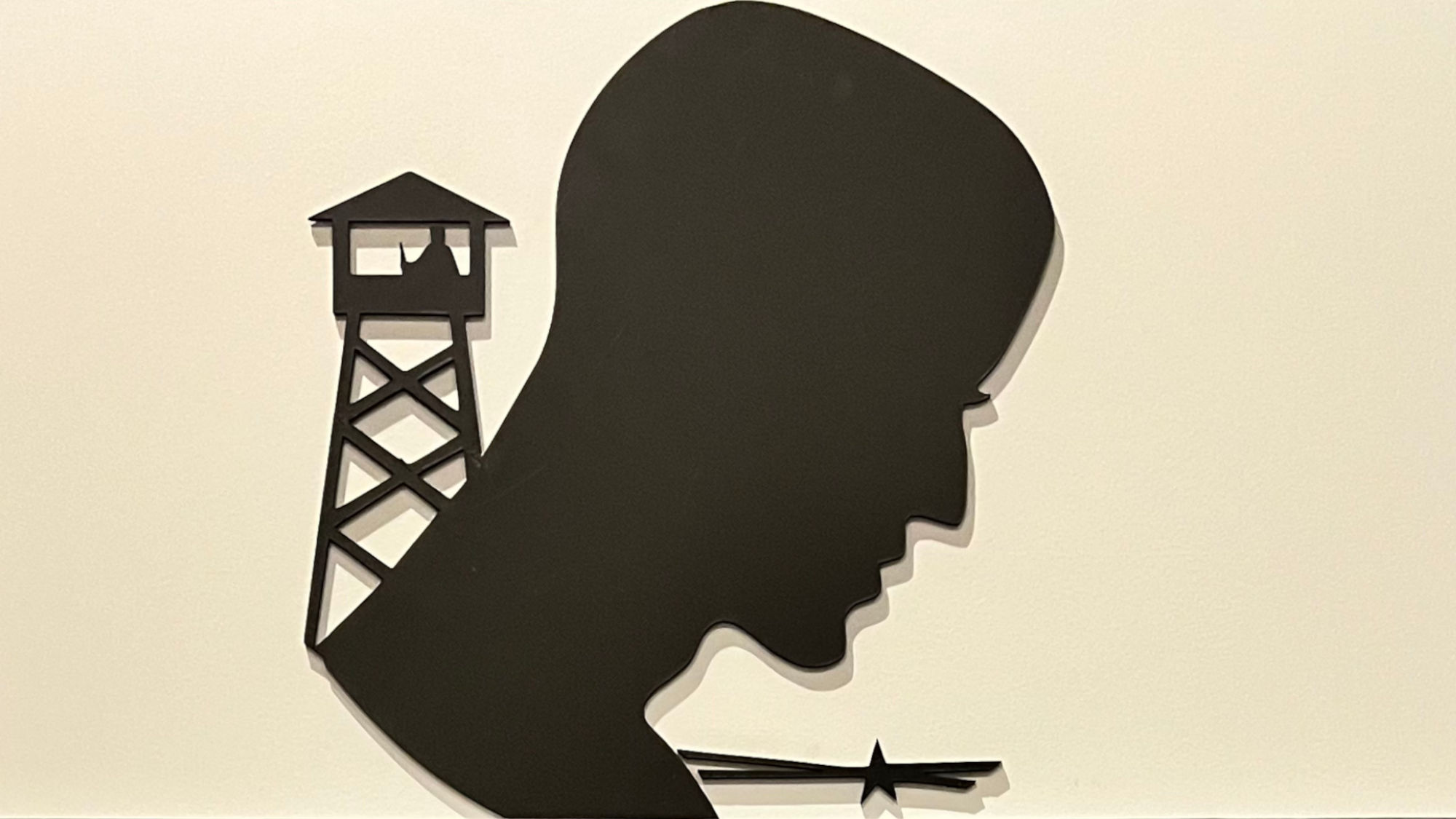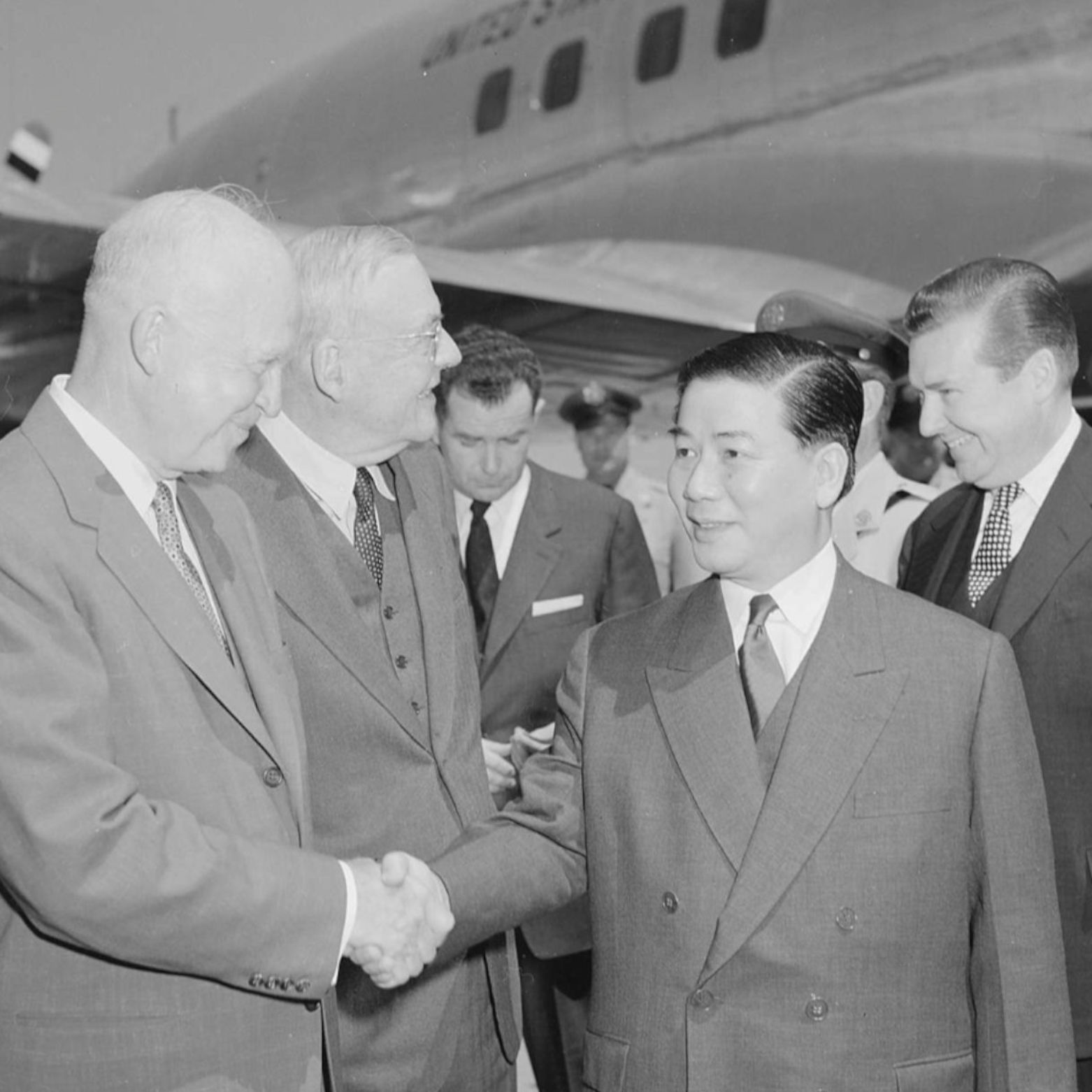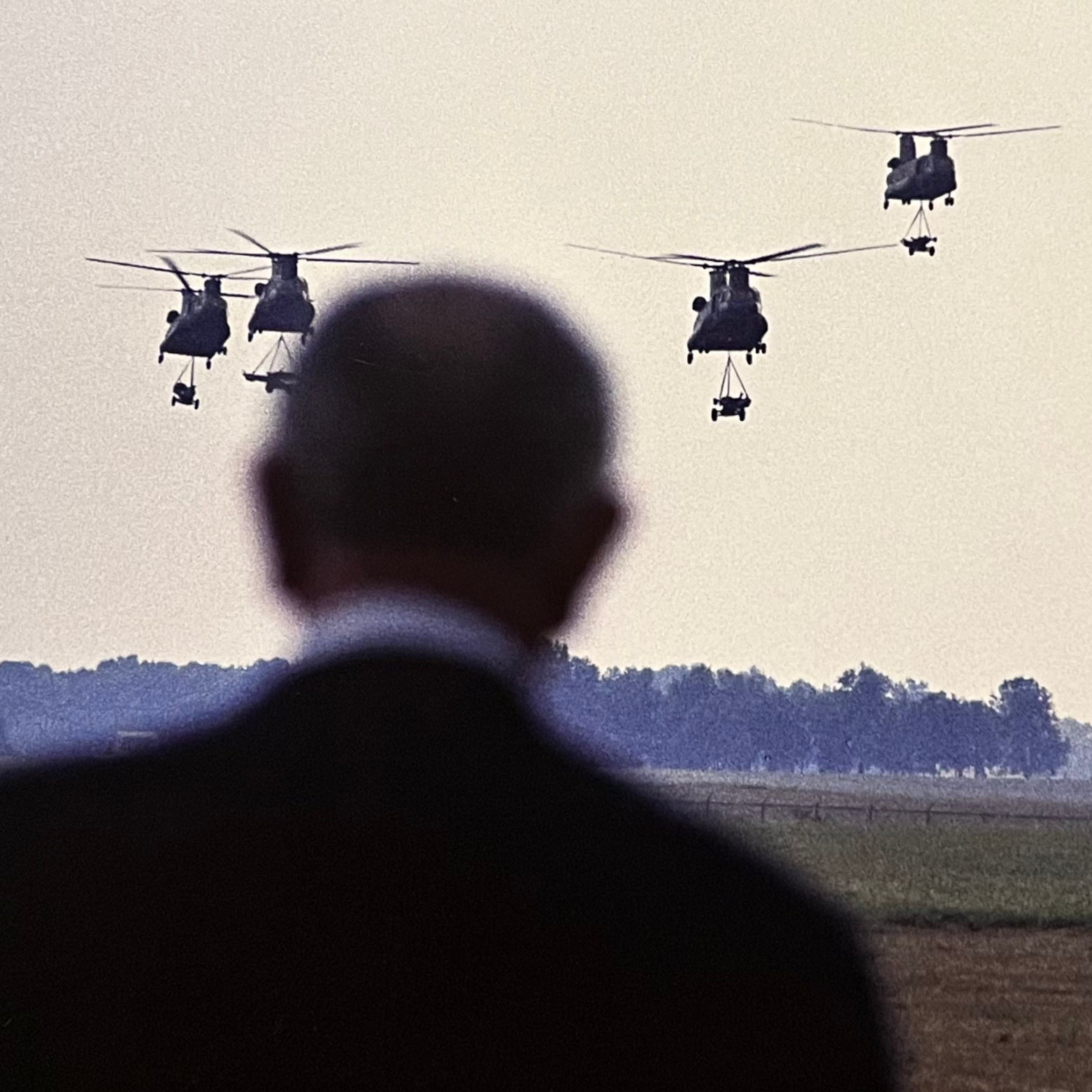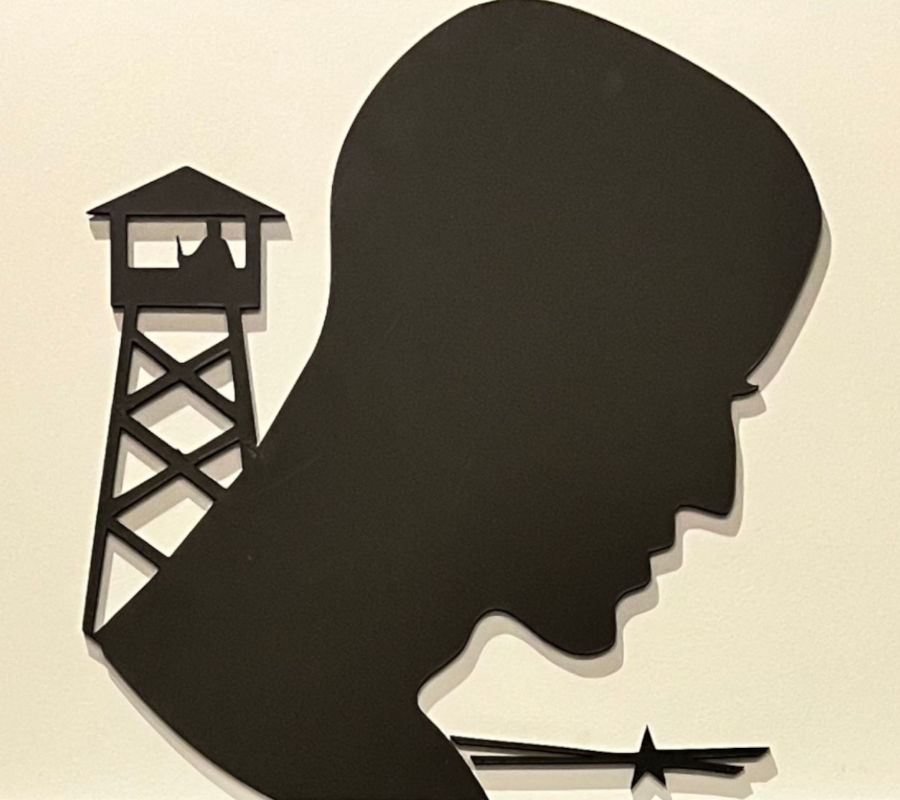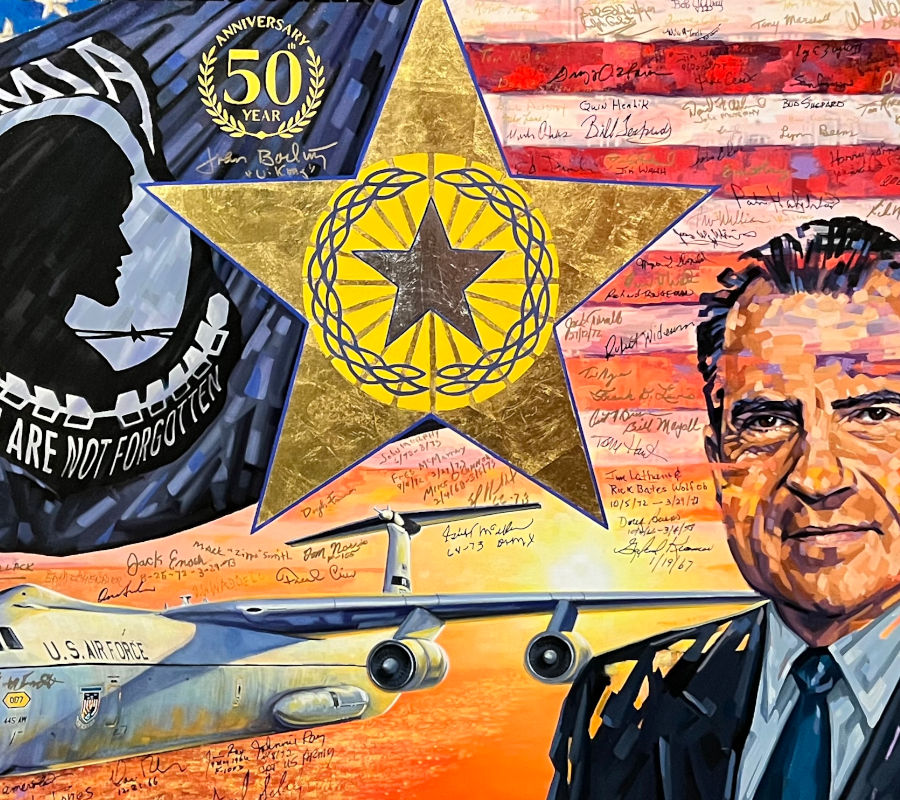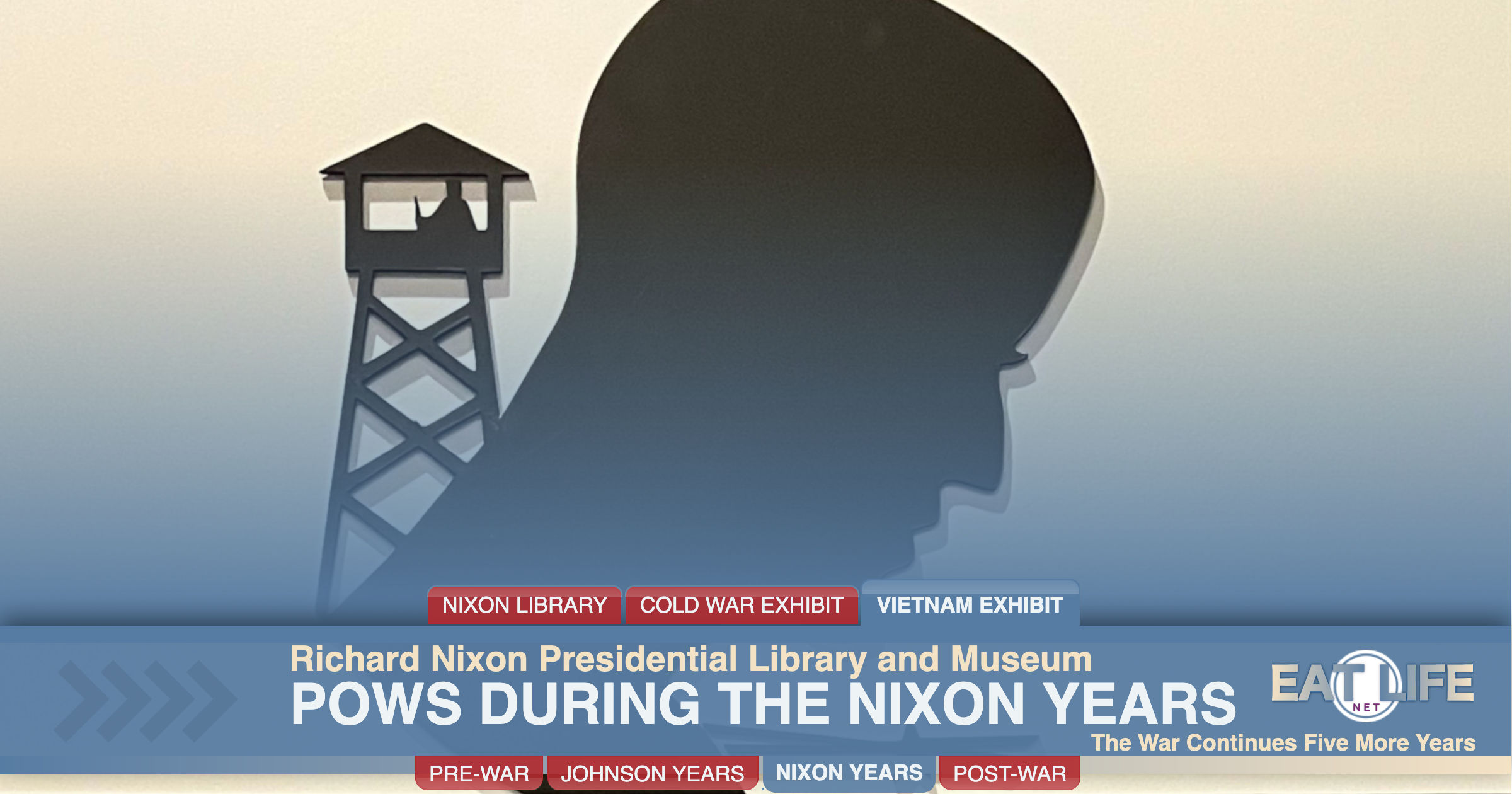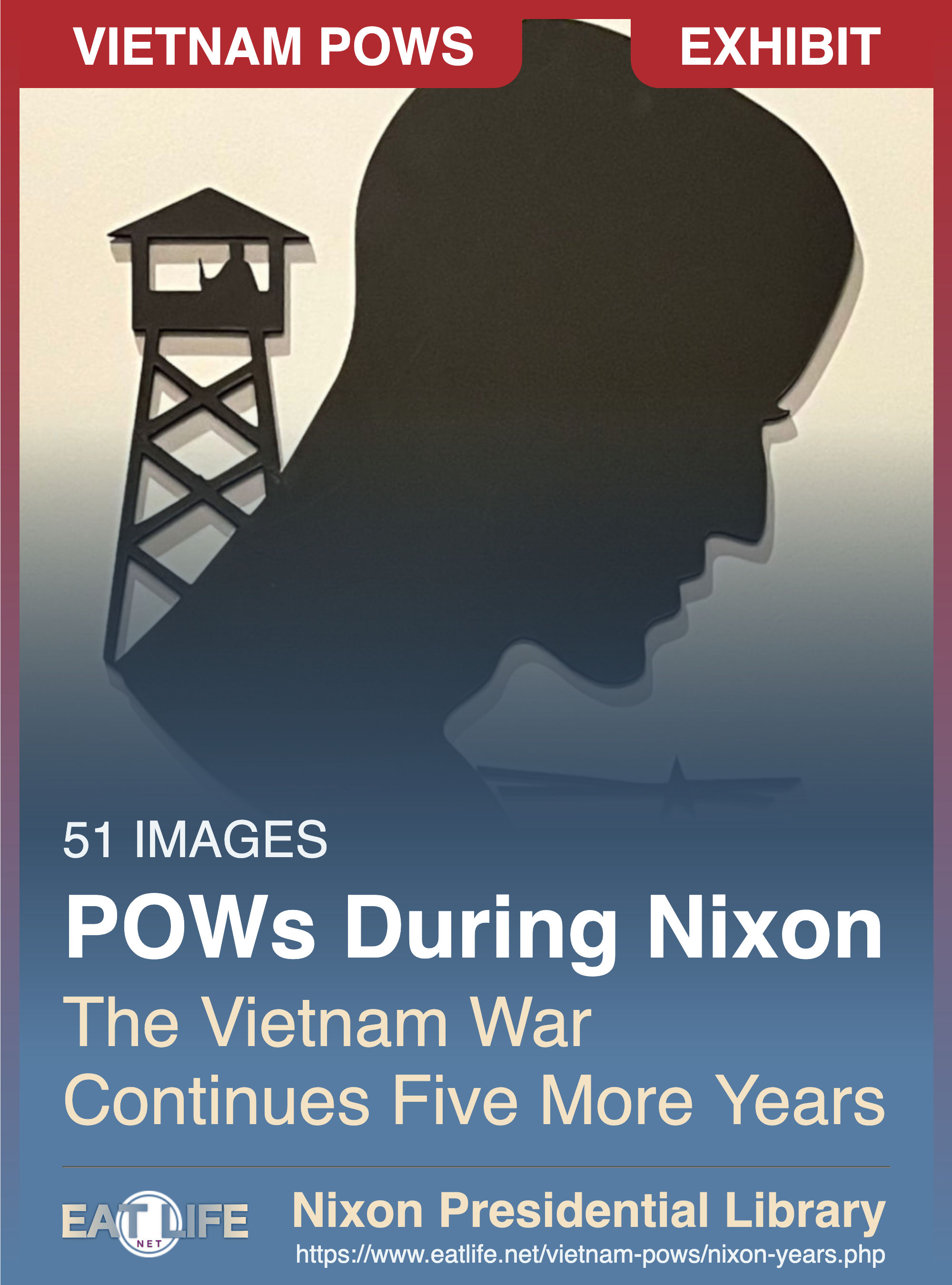VIETNAM EXHIBIT:
| THE NIXON YEARS: | |
|---|---|
| ON THIS PAGE | |
| 1968 | 1968 Campaign |
| Requirements For Peace | |
| 1969 | Alive or Dead? |
| Ross Perot's Christmas Delivery | |
| 1970 | Missing in Action |
| The Camps | |
| POW / MIA Bracelets | |
| 1971 | Write Hanoi |
| Live From Space | |
| 1972 | Air War in Vietnam |
| Operation Linebacker II | |
Campaign 1968 Vietnam
Americans were poised to choose a new commander-in-chief. President Lyndon B. Johnson had announced he would not seek re-election. The next president would inherit the war in Vietnam.
Many consider 1968 to have been the most turbulent year of the 1960s.
- The assassinations of Dr. Martin Luther King Jr. and Senator Robert F. Kennedy left the nation reeling.
- College campuses across the nation were rocked by anti-war protests.
- In late August, protesters disrupted the Democratic National Convention meeting in Chicago. The protests turned violent as local police confronted demonstrators in the streets surrounding the convention hall.
More than 500,000 Americans were fighting in Vietnam.
- 1968 would prove to be the deadliest year of the war, with 16,899 American lives lost.
- Negotiations in Paris between the United States and North Vietnam, which began in May, were making no progress toward ending the conflict.
- Hundreds of Americans were held under horrific conditions by North Vietnam as prisoners of war (POW). Many hundreds more were listed as missing in action (MIA).
On October 31, President Johnson announced an end to American bombing of North Vietnam. The South Vietnamese government did not respond to the bombing halt and did not agree to the announcement.
Five days later, Richard Nixon was elected president. Ending the war and securing the release of American POWs would soon become his responsibility.
Shortly after taking office in January 1969, President Nixon made the return of all American POWs a non-negotiable requirement for ending the war. He also insisted on a full accounting of the missing in action.
Requirements for Peace
Richard Nixon, the Republican candidate, sought an honorable end to the war. He opposed an immediate pull-out of all American troops. Nixon sought a negotiated agreement to end the war that would:
- Train South Vietnamese forces so American troops could be withdrawn.
- Secure the self-determination of the South Vietnamese people.
- Maintain the sovereignty of South Vietnam.
Vice President Hubert H. Humphrey, the Democratic candidate, also sought to end the war honorably. He pledged to:
- Make a complete reassessment of the situation in Vietnam.
- De-escalate the fighting and take "reasonable risks" to end the war.
- Seek to withdraw American troops by the end of 1969.
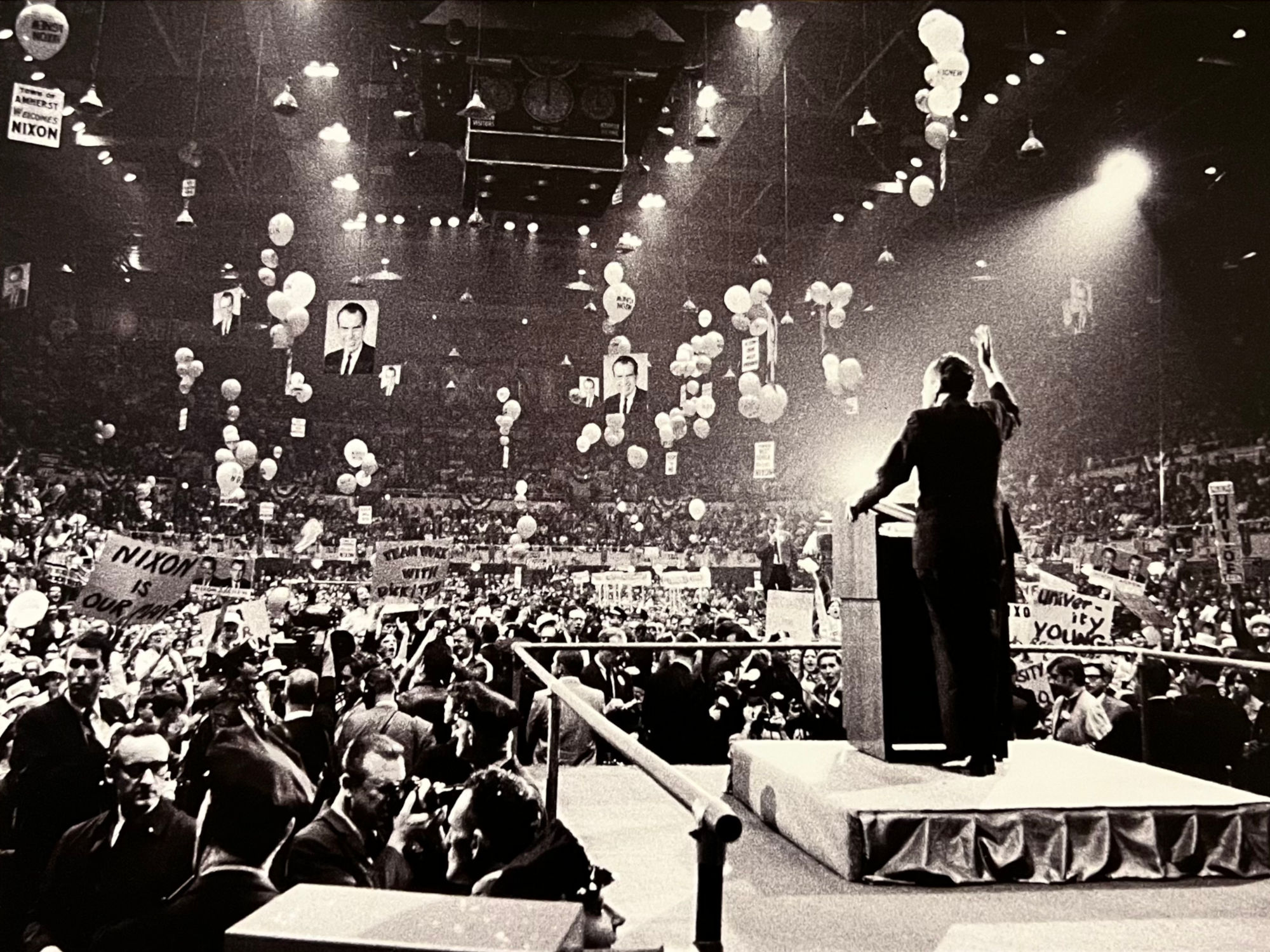
Richard M. Nixon
Amherst, Massachusetts
Republican candidate Richard Nixon addresses a huge rally in Amherst, Massachusetts during his 1968 campaign for president.
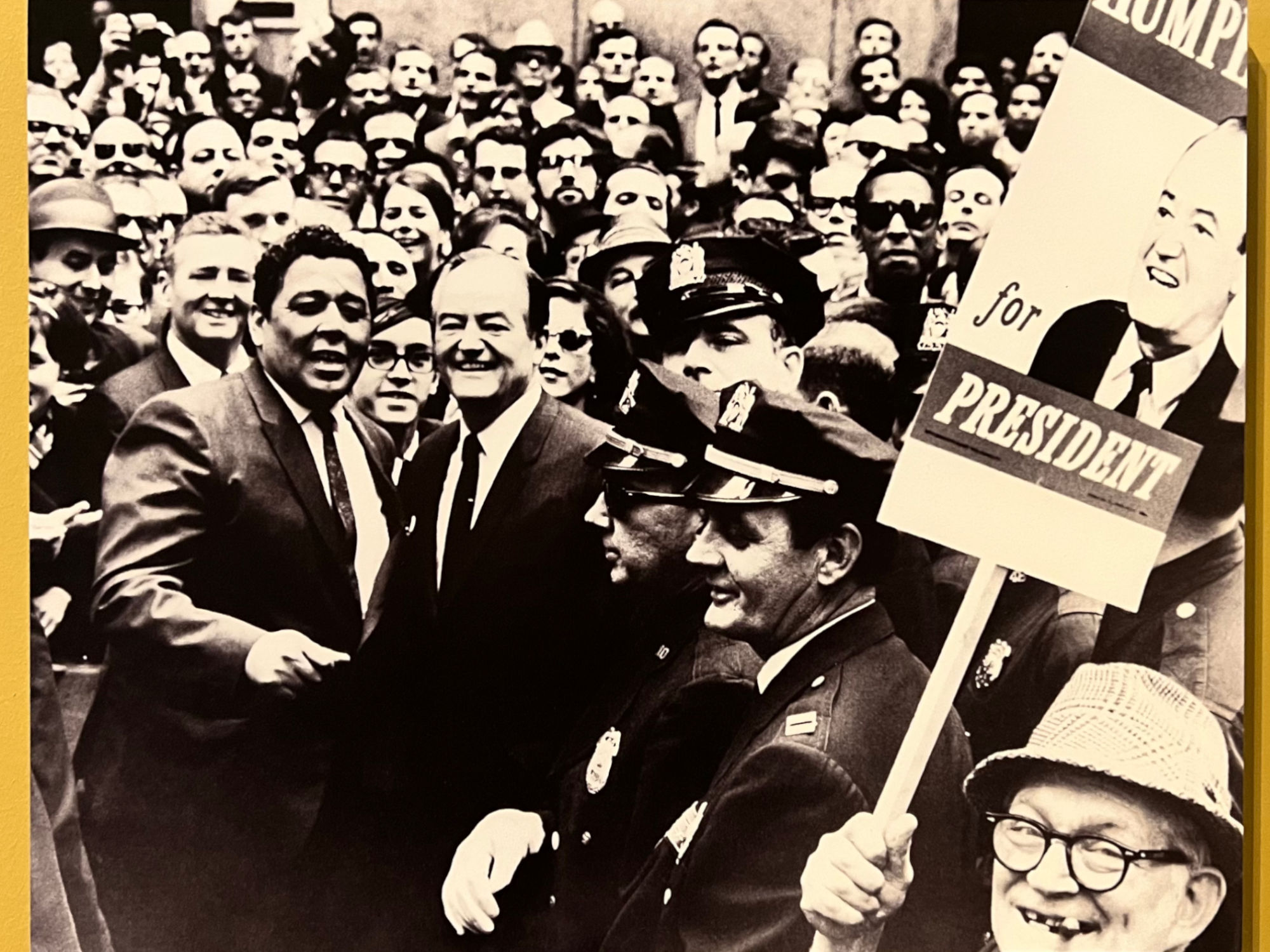
Hubert H. Humphrey
Salt Lake City, Utah
1968 Democratic nominee and Vice President Hubert H. Humphrey stands with a large crowd of supporters in Salt Lake City, Utah.
Richard Nixon Elected President
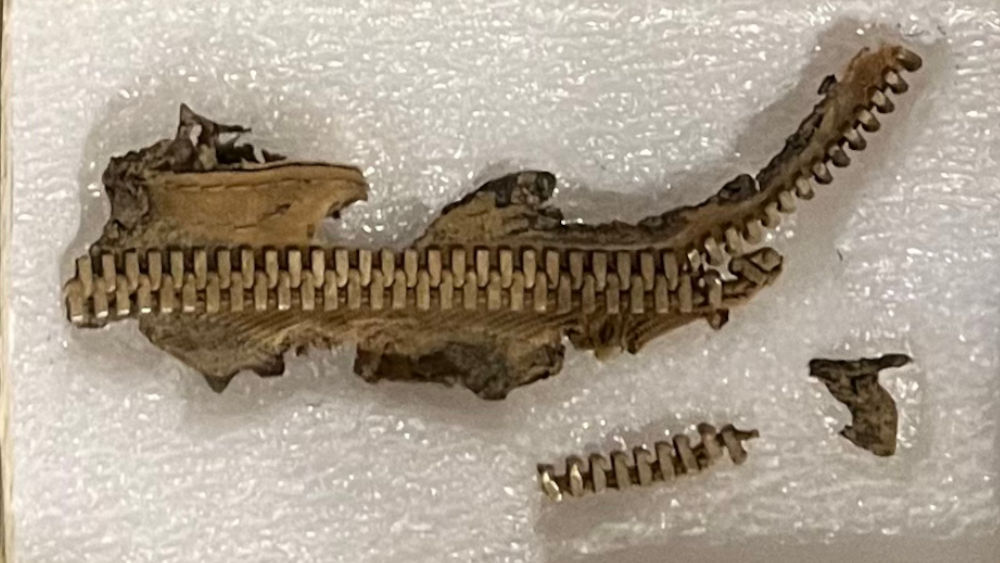
Virgil Kersh Meroney III
KIA near the Ban Karai Pass, Khammouane Province, Laos
Went missing in action on March 1, 1969. Bombardier / Navigator of an F4D Phantom assigned to the 433rd Tactical Fighter Squadron. Hit by hostile fire and crashed.
Items recovered from the crash site in 2012 by the Defense POW/MIA Accounting Agency while investigating Case 1396 on Air Force Captain Virgil Kersh Meroney III
- Life Support Zipper
- Rubber Tube from An Oxygen Hose
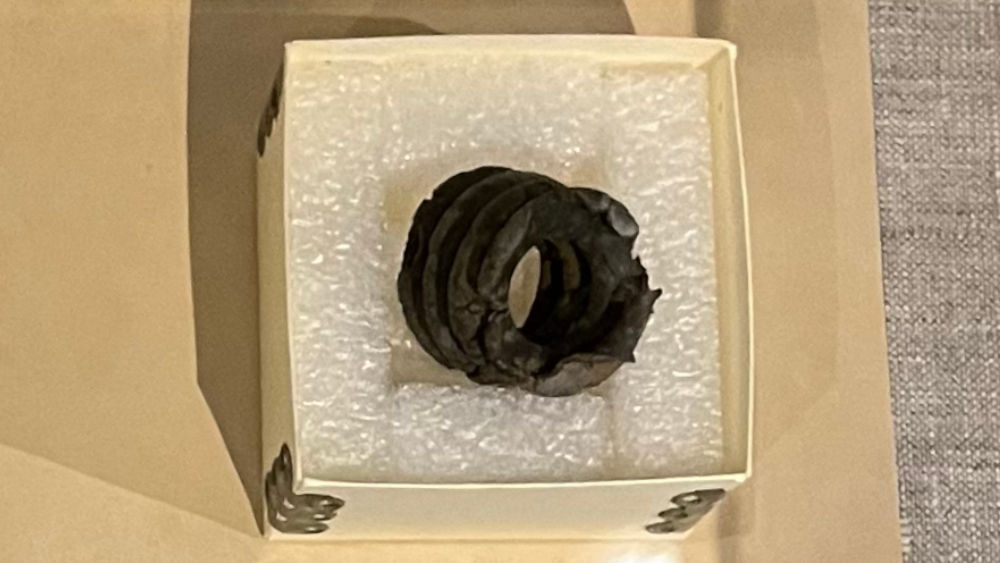
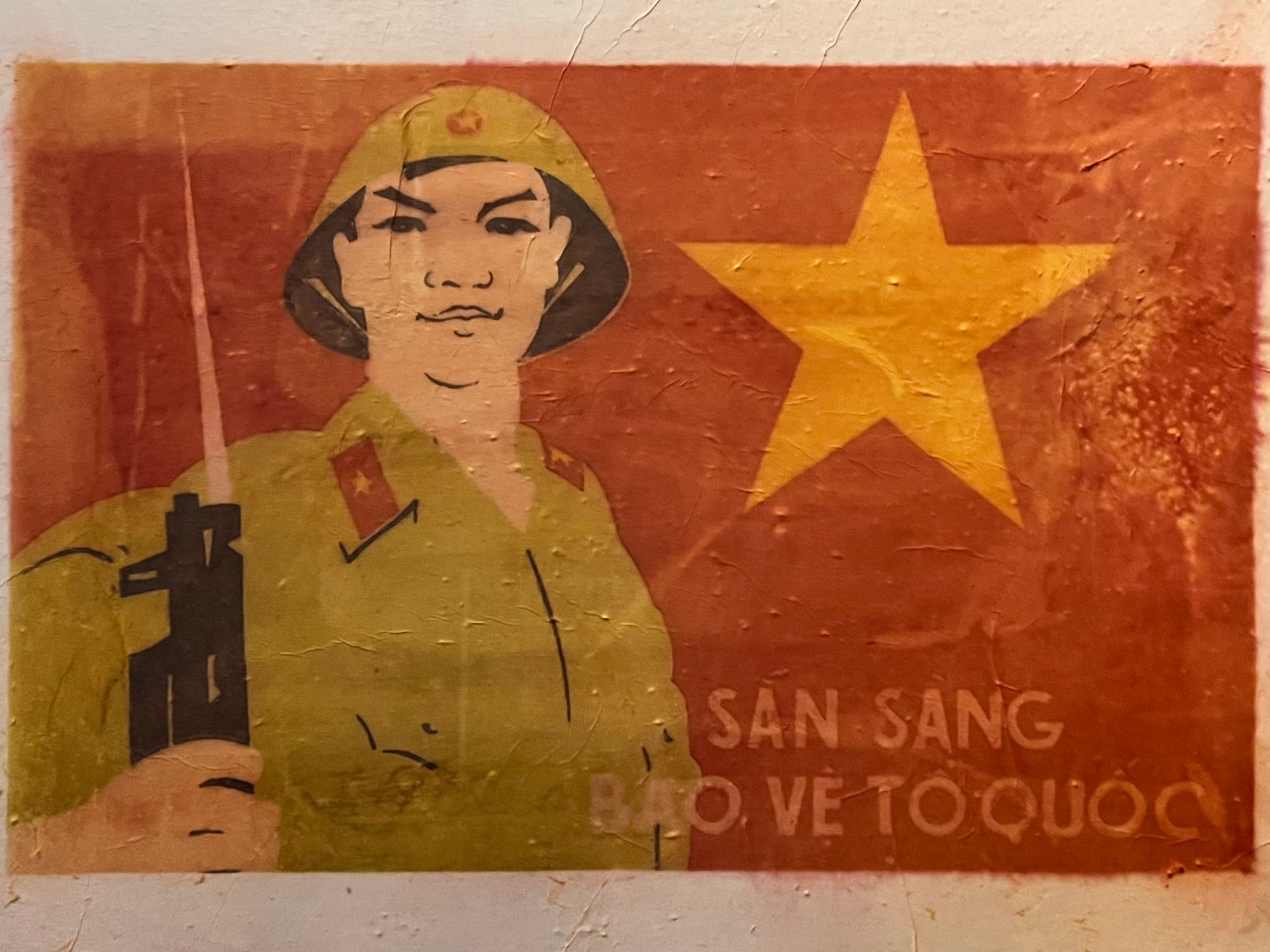
Propaganda Poster
Ready to Defend the Homeland
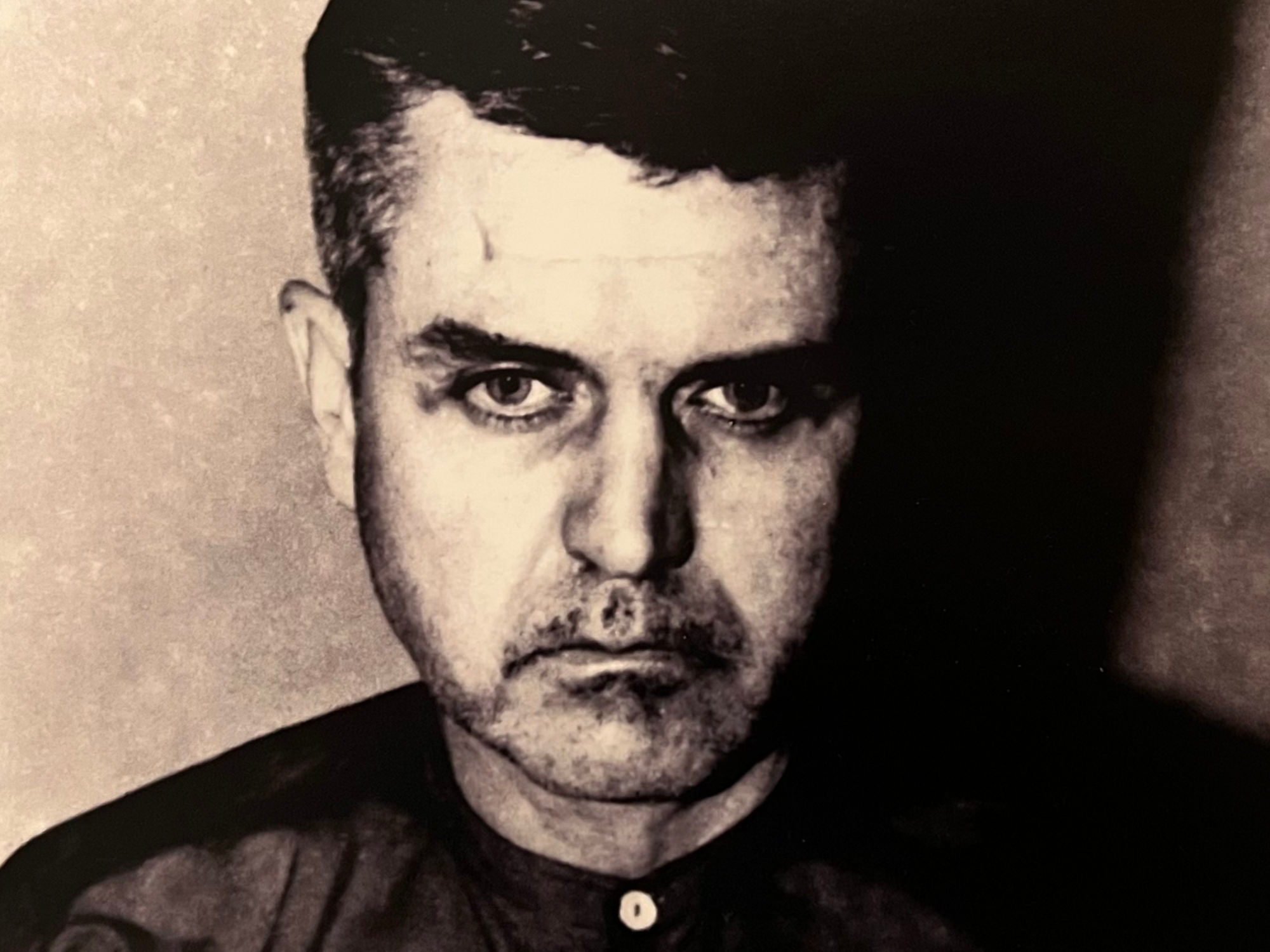
James Stockdale
Naval aviator Stockdale's solemn expression during his time in the Hanoi Hilton: 1965-1973.
In 1969, Commander Stockdale beat his face with a wooden stool and slashed his scalp to prevent his captors from using him for propaganda purposes in front of foreign journalists. In addition, he cut his own wrists to show his captors that he would rather die than give any information. These acts would help lead to the end of North Vietnamese using excessive torture on POWs.
Alive or Dead?
The North Vietnamese refused to provide the International Red Cross with a list of the Americans held as prisoners of war. Some information would dribble out. The vast majority of family members were left in agonizing uncertainty. That would change for many of them in the summer of 1969.
I don't understand how the North Vietnamese can be so lacking in humanity that they won't even give us the names of the prisoners they have.
- Secretary of State William P. Rogers, 1969
The North Vietnamese refused to provide the International Red Cross with a list of the Americans held as prisoners of war. Some information would dribble out. The vast majority of family members were left in agonizing uncertainty. That would change for many of them in the summer of 1969.
The North Vietnamese released three prisoners of war on August 5, 1969. Among them was a sailor, Douglas Hegdahl. The POWs held there had made a "No Go Home Early" agreement and he did not want to go. But Hegdahl's commanding officer ordered him to do so that he could provide the U.S government with valuable information.
Using the childhood song Old McDonald Had a Farm as a memory device, Hegdahl could remember the names, dates of capture and arrival, and other personal information of more than 250 fellow POWs.
The information Hegdahl provided helped ease the minds of the families of those he accounted for. But due to North Vietnam's refusal to provide a complete account, hundreds more families remained in a sort of purgatory.
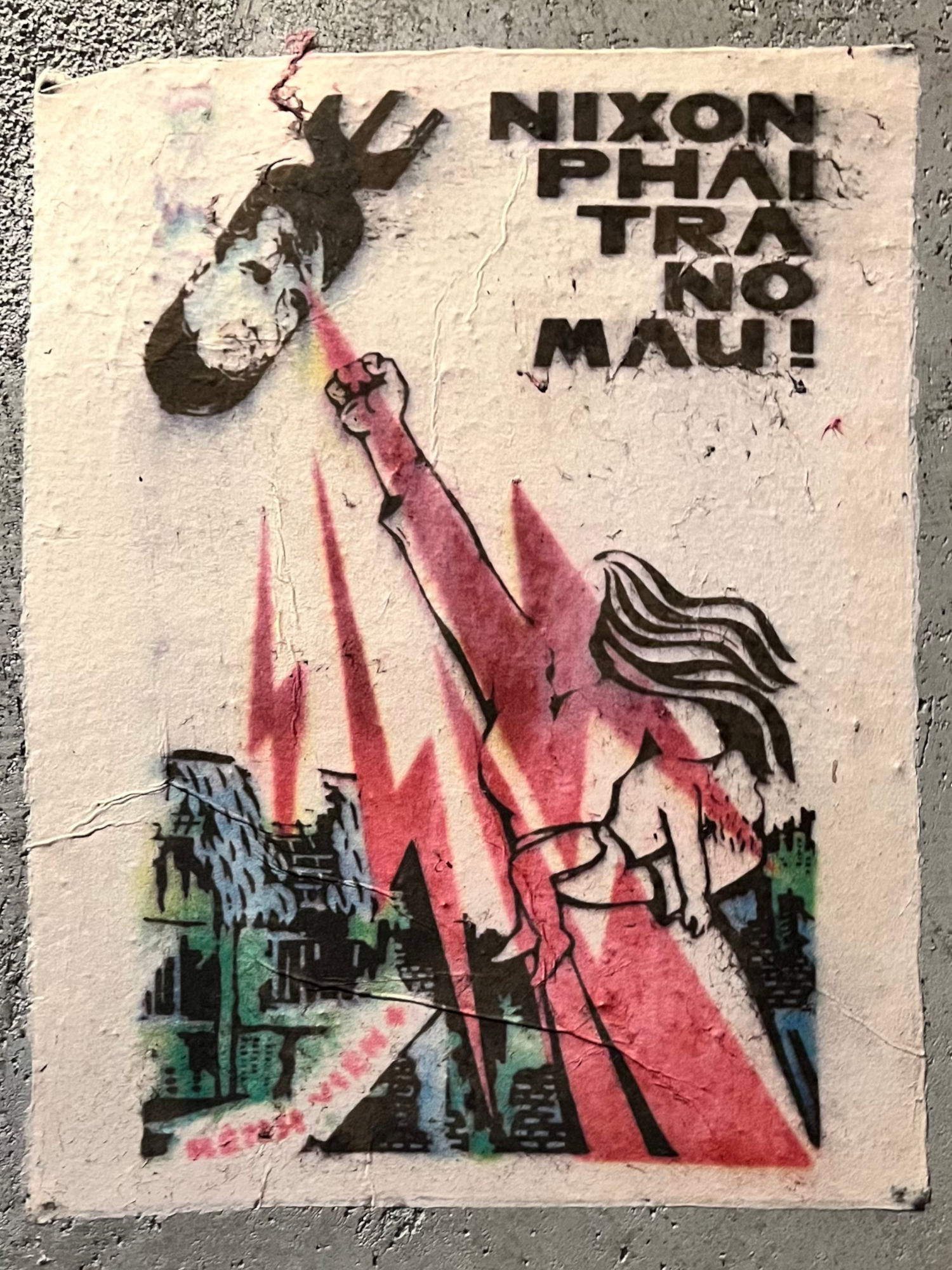
Propaganda Poster
An Eye For An Eye
Nixon must pay for our blood with his blood
Ho Chi Minh Dies
President of the Democratic Republic of VietnamHo Chi Minh has a heart attack and is in bad health for the rest of the year
- Died on September 2, 1969. 79 Years Old, Heart Failure
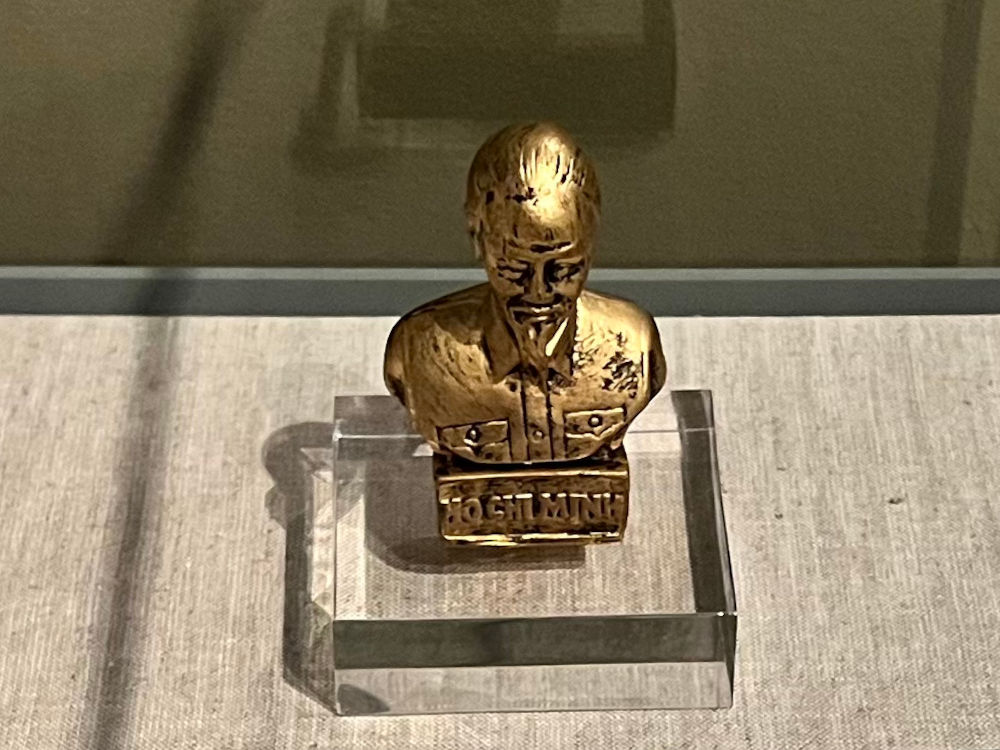
Ho Chi Minh Bust
Viet Cong
Small metallic bust of Democratic Republic of Vietnam President Ho Chi Minh. From 1945 to 1969, Ho was the face of the Vietnamese nationalist movement and is widely regarded as one of the 20th century's most prominent communist leaders.
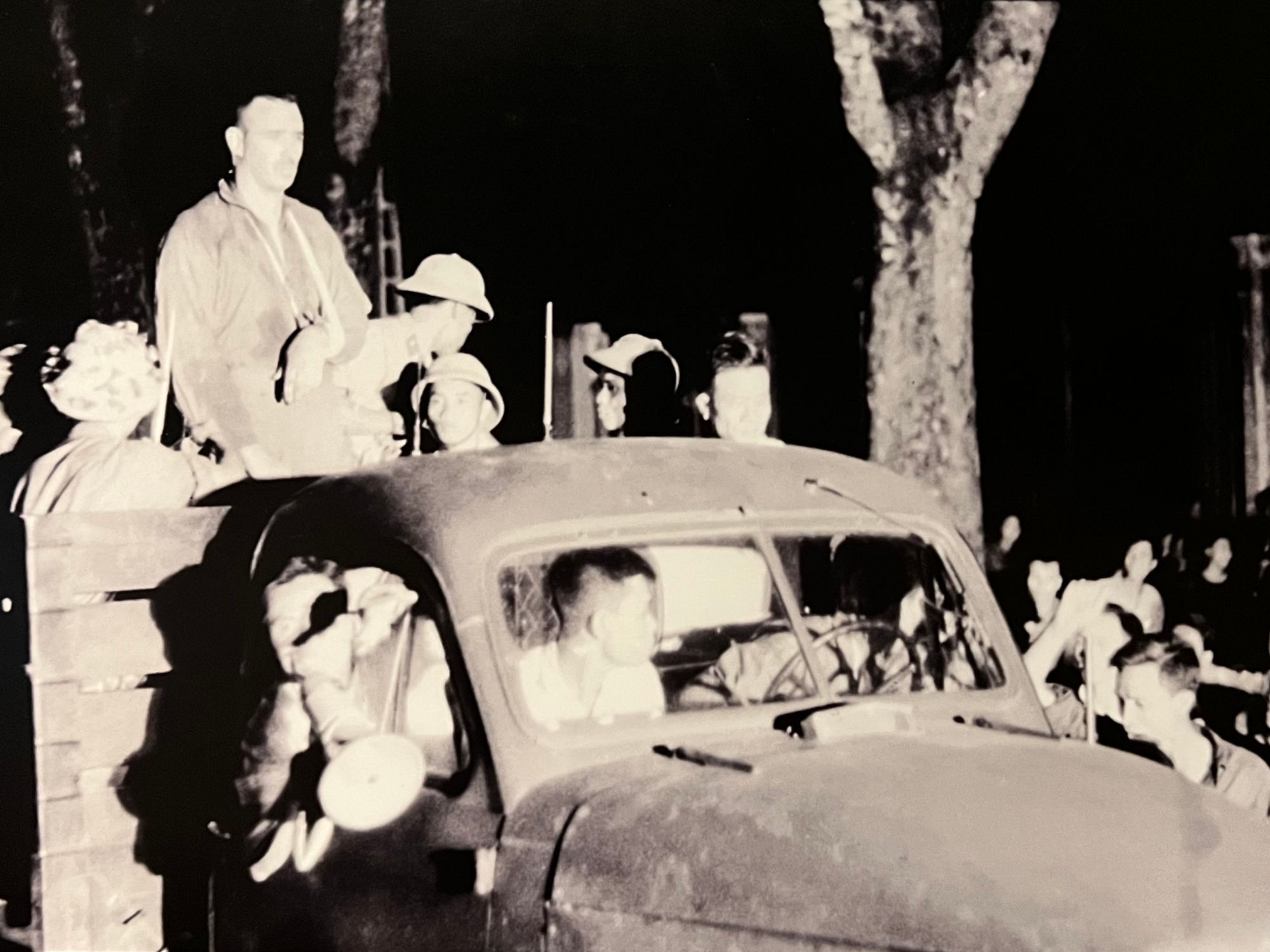
Murphy Neal Jones
Propaganda
U.S. Air Force Captain Murphy Jones is paraded around in a truck like a war trophy for the North Vietnamese media and public, September 26, 1969.
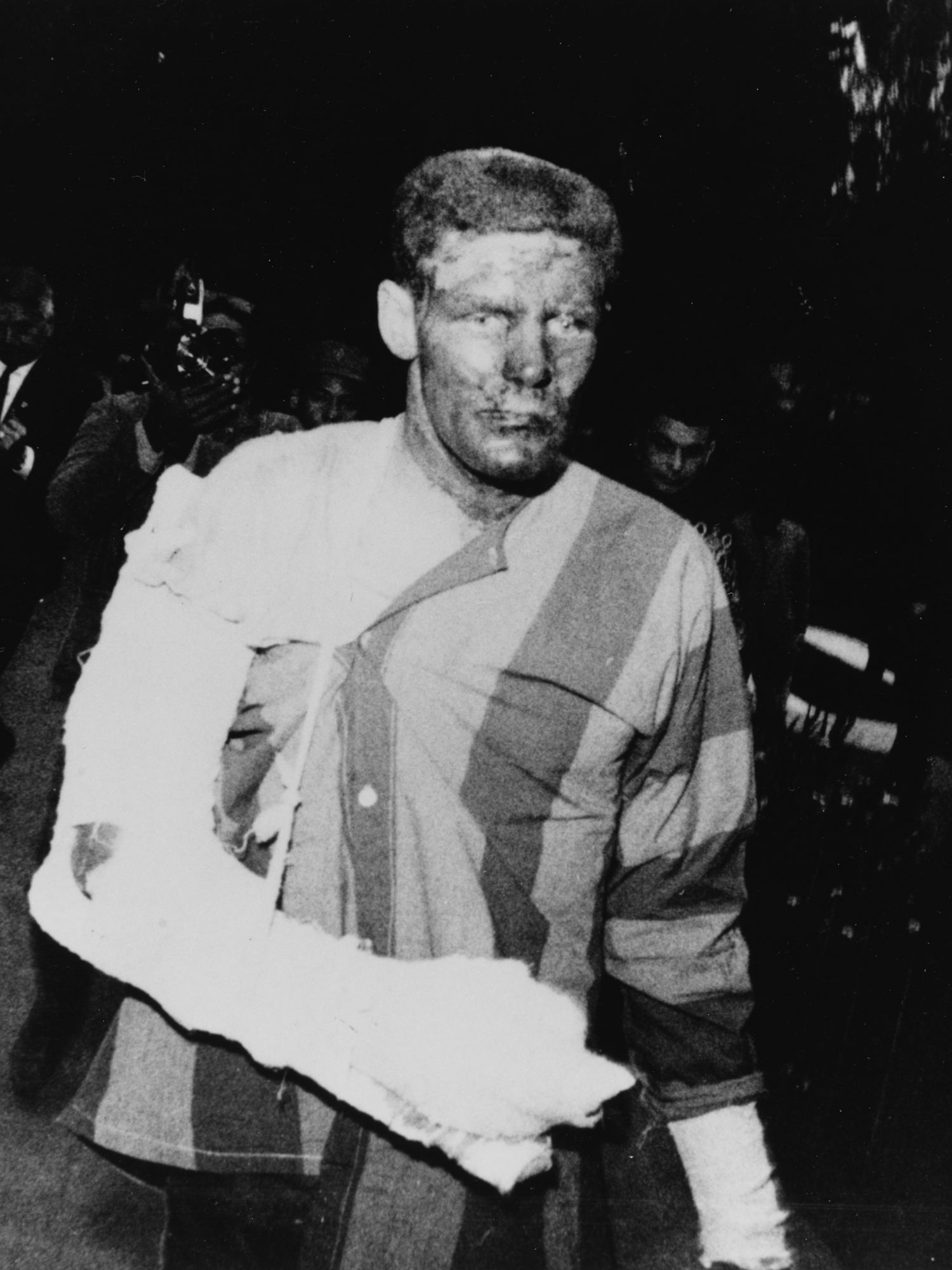
David B Rehman
Propaganda
U.S. Navy Lieutenant David B Rehman, his arm in a makeshift cast, on a forced march on September 26, 1969.
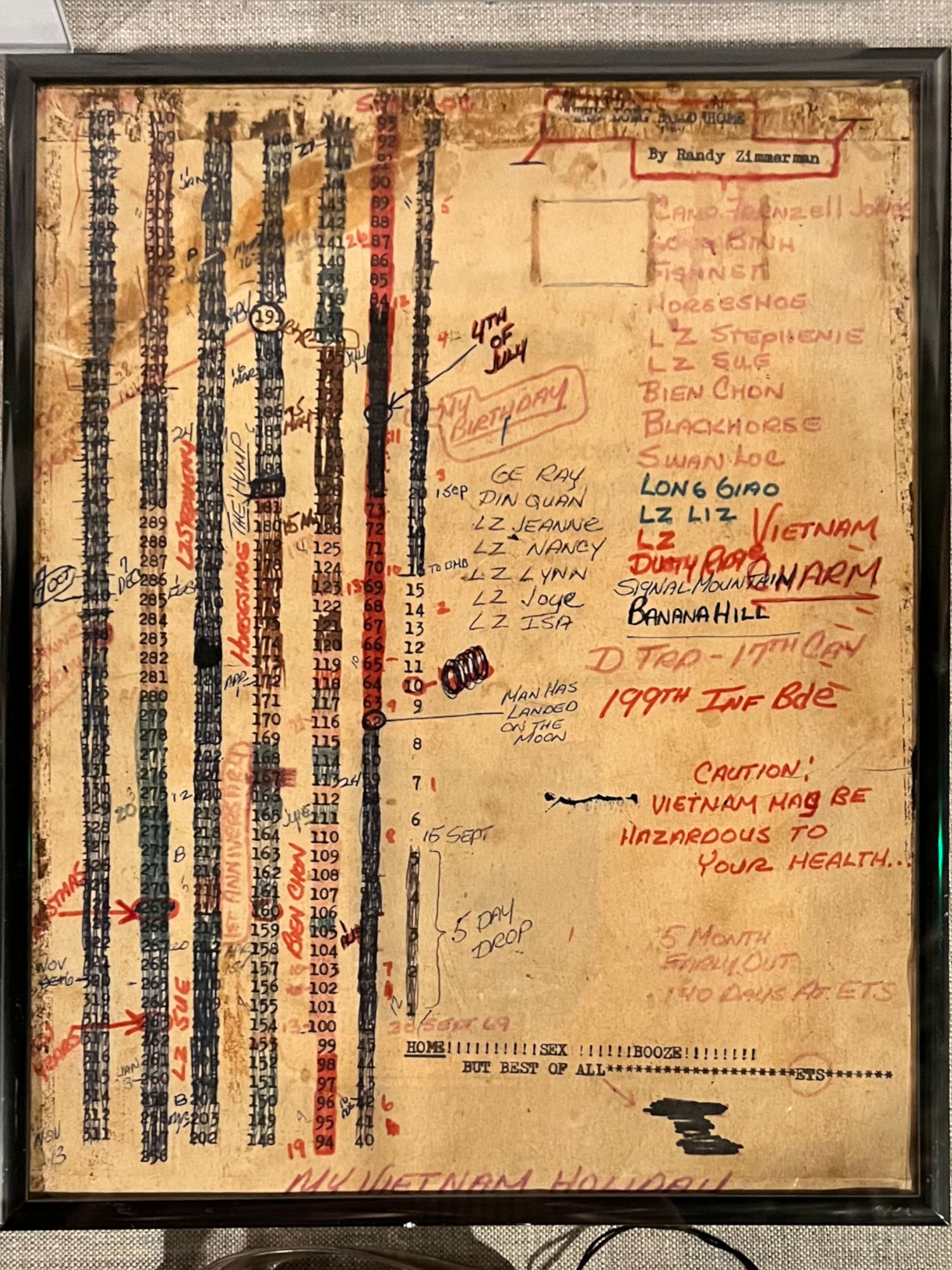
Randy Zimmerman
My Vietnam Holiday
Randy Zimmerman kept this short-timer calendar, titled "The Long Road Home," while he served in Vietnam. Locations such as LZ Sue, Horseshoe, and Bien Chon are included alongside certain dates. Additional entries for "My Birthday" and "Man Has Landed on the Moon" are in the margins. Along the bottom of the calendar are the words "My Vietnam Holiday."
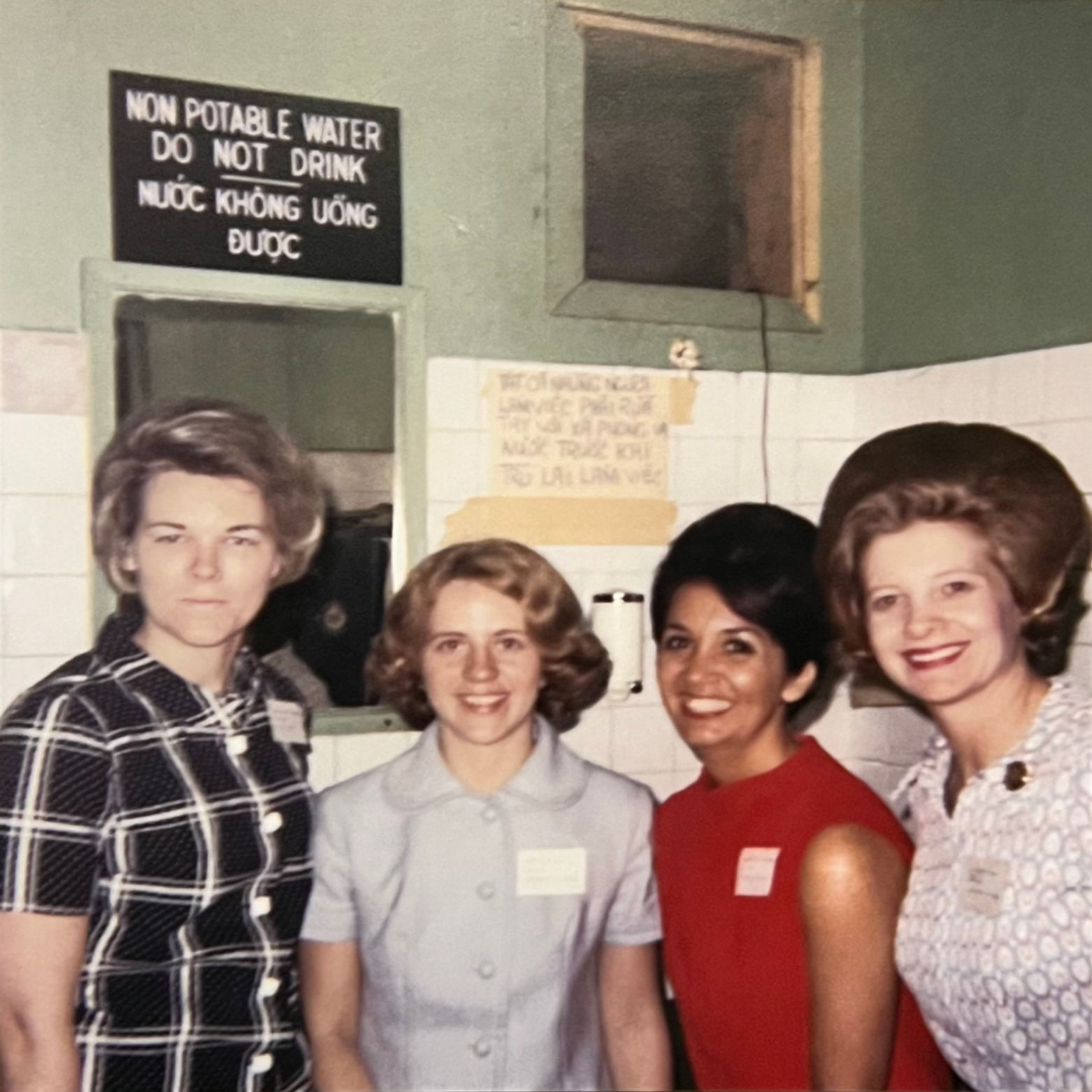
Paris Peace Talks
National League of POW/MIA Families
Some of the members of the National League of Families of American Prisoners and Missing in Southeast Asia traveled to Paris to advocate for American POWs.
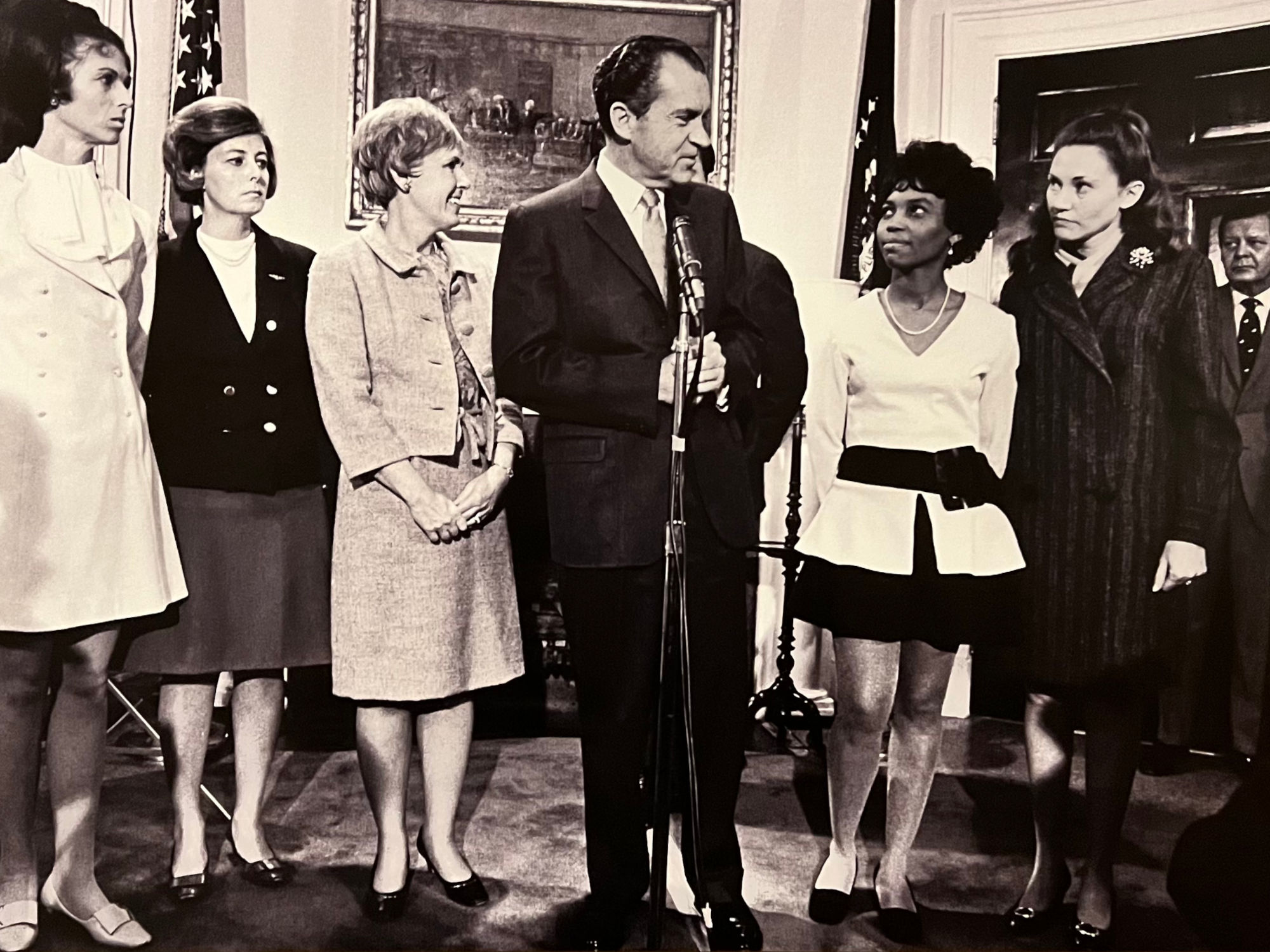
POW Wives
White House
President Richard Nixon meets with wives of American POWs in the Roosevelt Room at the White House. Such meetings helped raise the POW issue to national attention.
- Carole Hansen
- Louise Mulligan
- Sybil Stockdale
- Andrea Rander
- Mary Mearns
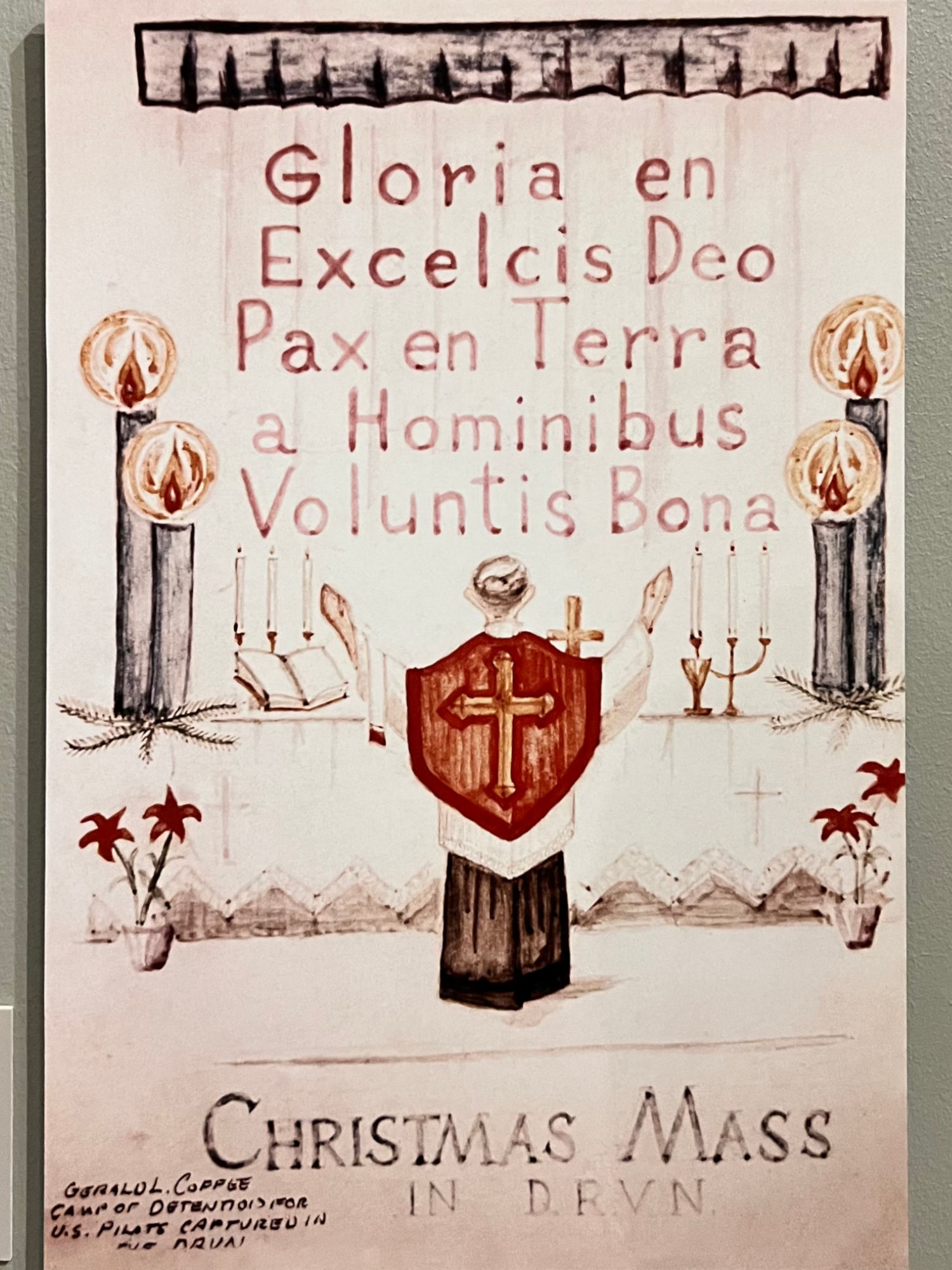
Christmas Mass in Progress
Camp of Detention for U.S. Pilots Captured in the Democratic Republic of Vietnam
U.S. Navy Lieutenant Gerald L. Coffee's drawing of a POW's Catholic Mass for Christmas, made while in North Vietnamese captivity.
Ross Perot's Christmas Delivery
Texas businessman H. Ross Perot was known nationwide as a strong supporter of the prisoners of war held in Vietnam and their families. The billionaire founder of Electronic Data Systems, Perot established a group he called United We Stand. Through this organization, he worked to raise awareness about the plight of the POWs.
United We Stand hit the ground running. In the fall of 1969, a wire service story reported on the group's efforts,
A month later, Perot announced a bold and audacious plan. United We Stand would charter an airplane to fly Christmas gifts, holiday dinners, medical supplies, and other items to Hanoi for delivery to the POWs. Although North Vietnam had not yet responded to his request that the plane be granted permission to land in Hanoi, Perot said the flight would leave regardless.
Four days before Christmas the jet christened "Peace on Earth" left for Southeast Asia carrying 30 tons of gifts and supplies for the POWs.
The plane arrived on Christmas Eve, but the North Vietnamese refused to grant permission to fly to Hanoi. Instead, they would only accept the cargo if it was delivered through the Soviet Union. The Soviets refused to allow the jet to land in Moscow. None of the gifts and supplies would reach the POWs.
Nevertheless, Perot's Christmas delivery raised awareness about the plight of the POWs and according to a senior Pentagon official, gave
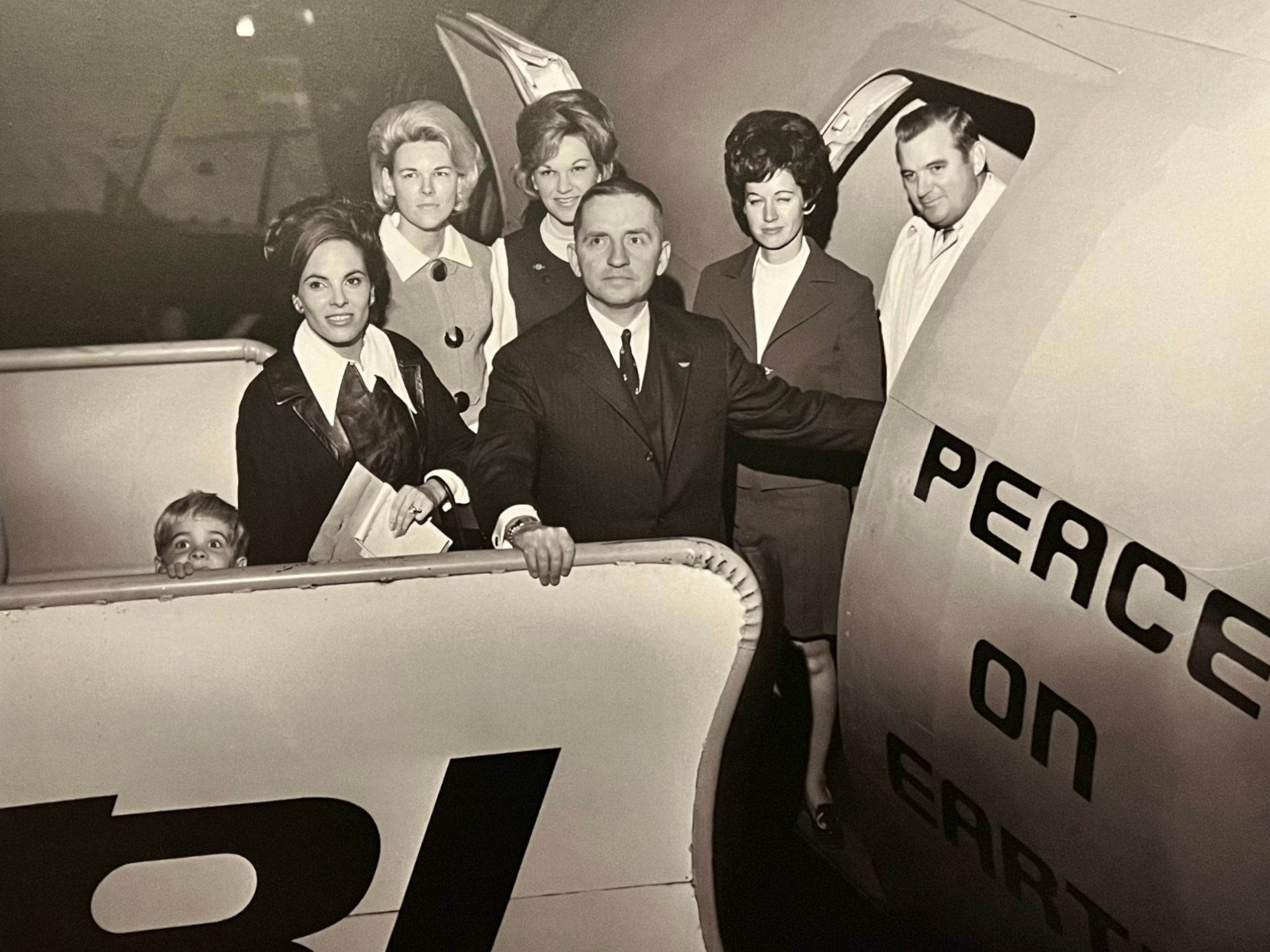
Peace on Earth
Ross Perot
Texan businessman Ross Perot and POW wives groups spearheaded civilian efforts to raise awareness about the plight of the POWs.
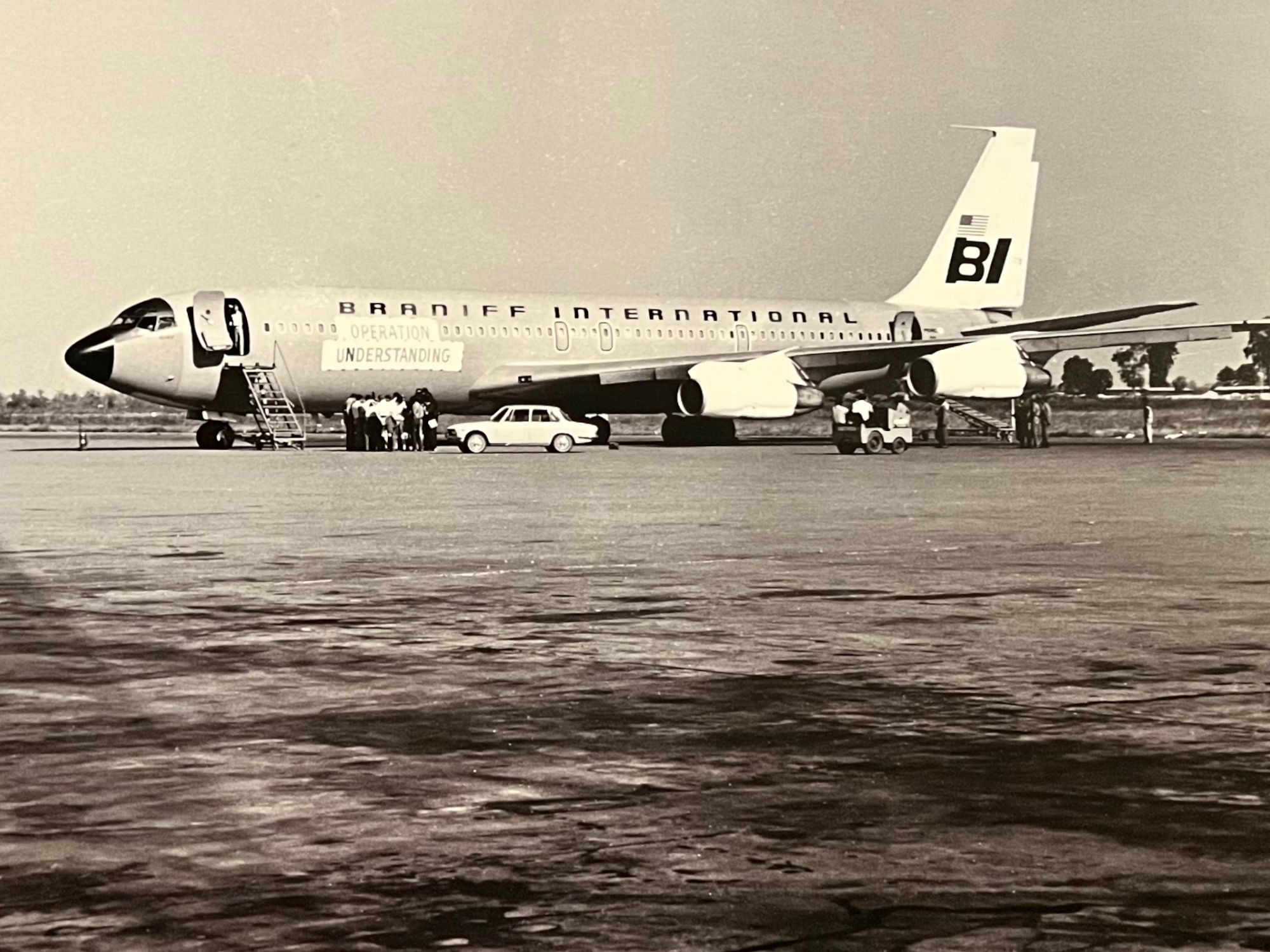
Operation Understanding
Ross Perot
Perot's plane loaded with basic supplies prepares for a mission to North Vietnam. Boxes of supplies, food, and Christmas presents are prepared for loading onto the Christmas flight to North Vietnam.
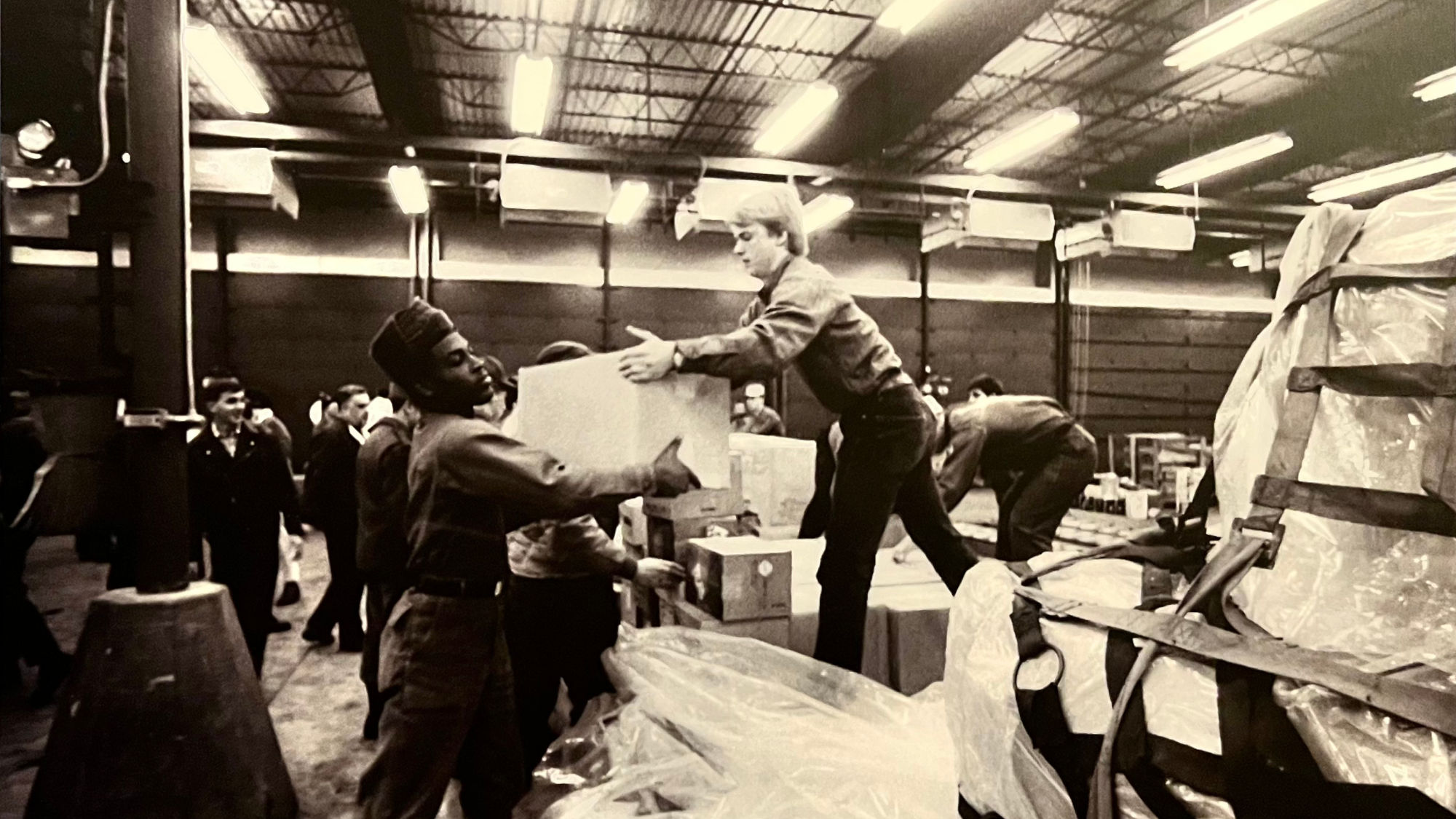
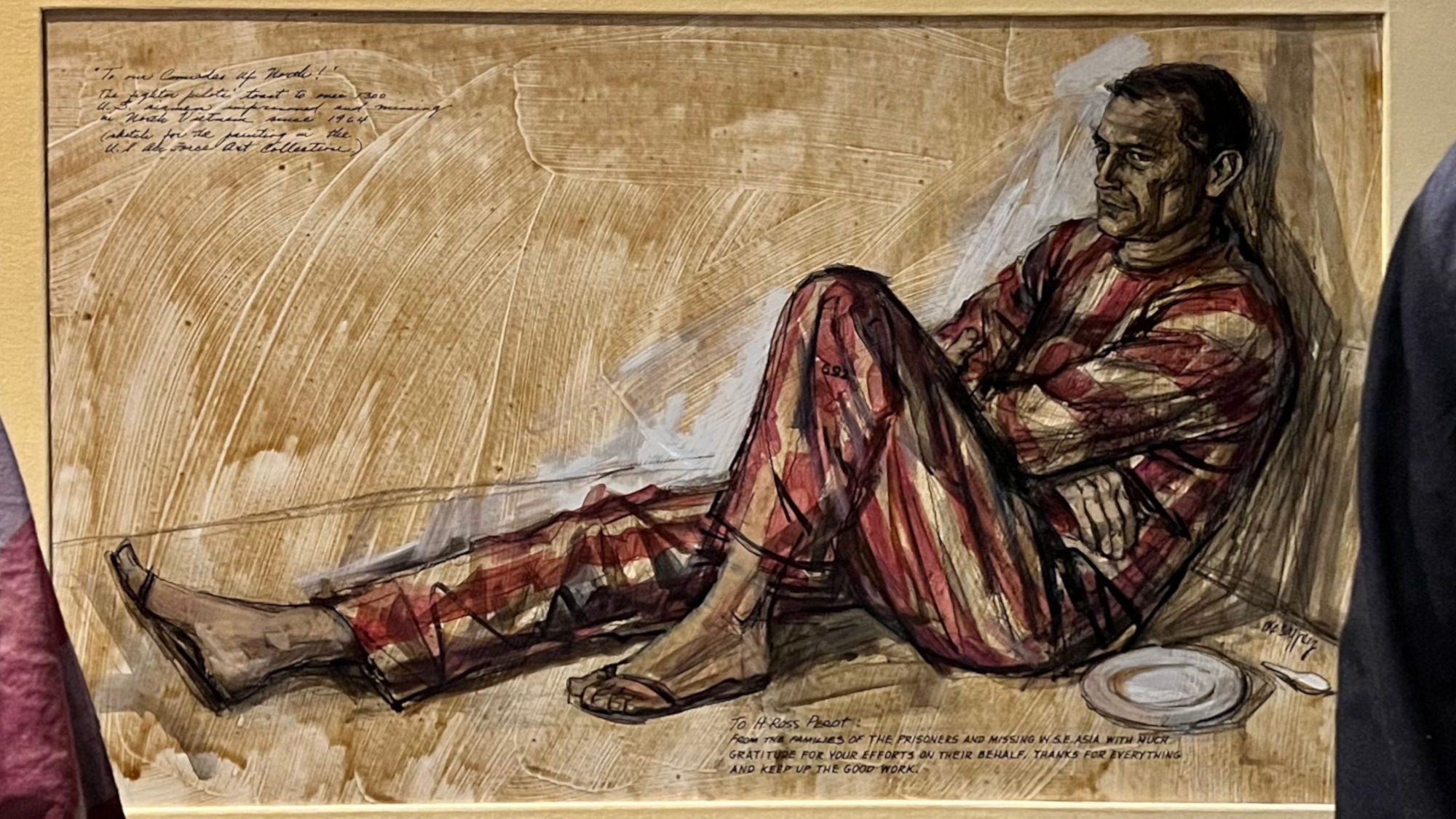
To Our Comrades Up North
POW Painting
POWs endured psychological abuse and torture at the hands of their North Vietnamese captors. A prison guard told one new arrival, "It's easy to die, but hard to live, and we'll show you just how hard it is to live." Isolation, starvation, and beatings were the norm. This painting of a POW slumped against a cell wall depicts the desolate and grueling nature of life inside a prison camp.
To our comrades Up North! Fighter pilots toast to over 1300 U.S. Airmen imprisoned and missing in Hanoi, North Vietnam since 1964.
To: H. Ross Perot
From the families of the Prisoners and Missing in S.E. Asia with much gratitude for your efforts on their behalf. Thanks for everything and keep up the good work.
Missing in Action
In every war, some members of the military are regrettably unaccounted for. Whether they were shot down, on warships lost at sea, killed in inaccessible terrain, or unidentifiable, these warriors are never forgotten.
During the course of the Vietnam War, 2,641 members of the armed services were listed as MIA. There remain 1,581 MIAs from the Vietnam War.
The United States is committed to leaving no one behind.
Through the work of the POW/MIA Accounting Agency, the Department of Defense honors that commitment. Its mission is simply stated but profound: Provide the fullest possible accounting for our missing personnel to their families and the nation.
The National League of POW/MIA Families, founded in 1970, is an effective advocate for making a full accounting of all Vietnam War MIAs and returning the remains of those who died during the war.
Family members and comrades-in-arms of the missing also conduct searches for evidence of their fates. Although it is unlikely that every Vietnam War MIA will be accounted for, the search continues.

Bumper Stickers
POWs Never Have a Nice Day
Items like this bumper sticker were made to express growing displeasure in the United States' involvement in the Vietnam War. The text along the bottom reads
Don't Let Them Be Forgotten
Vietnam War-era bumper stickers and buttons helped bring awareness to the plight of the POWs.

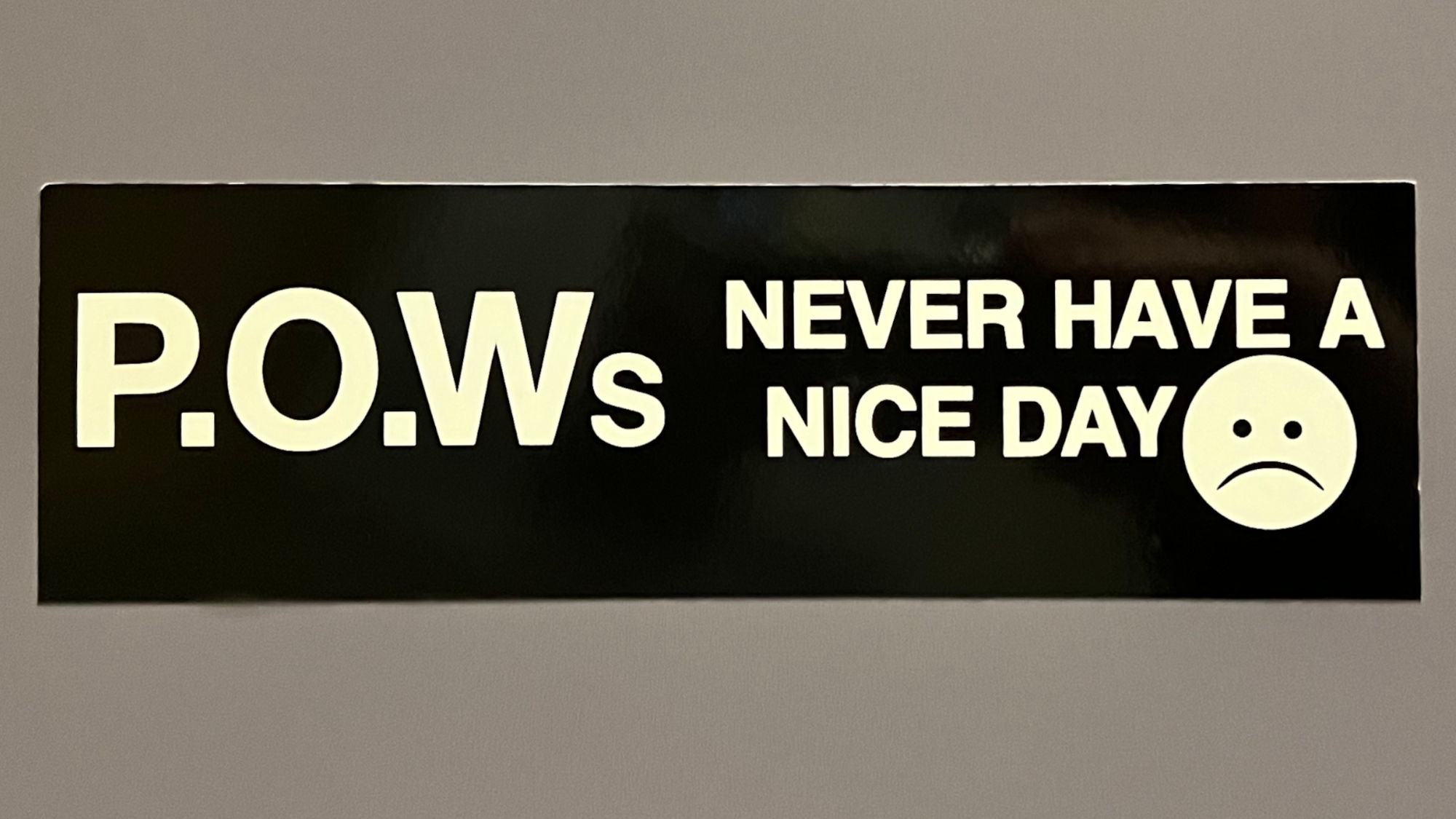
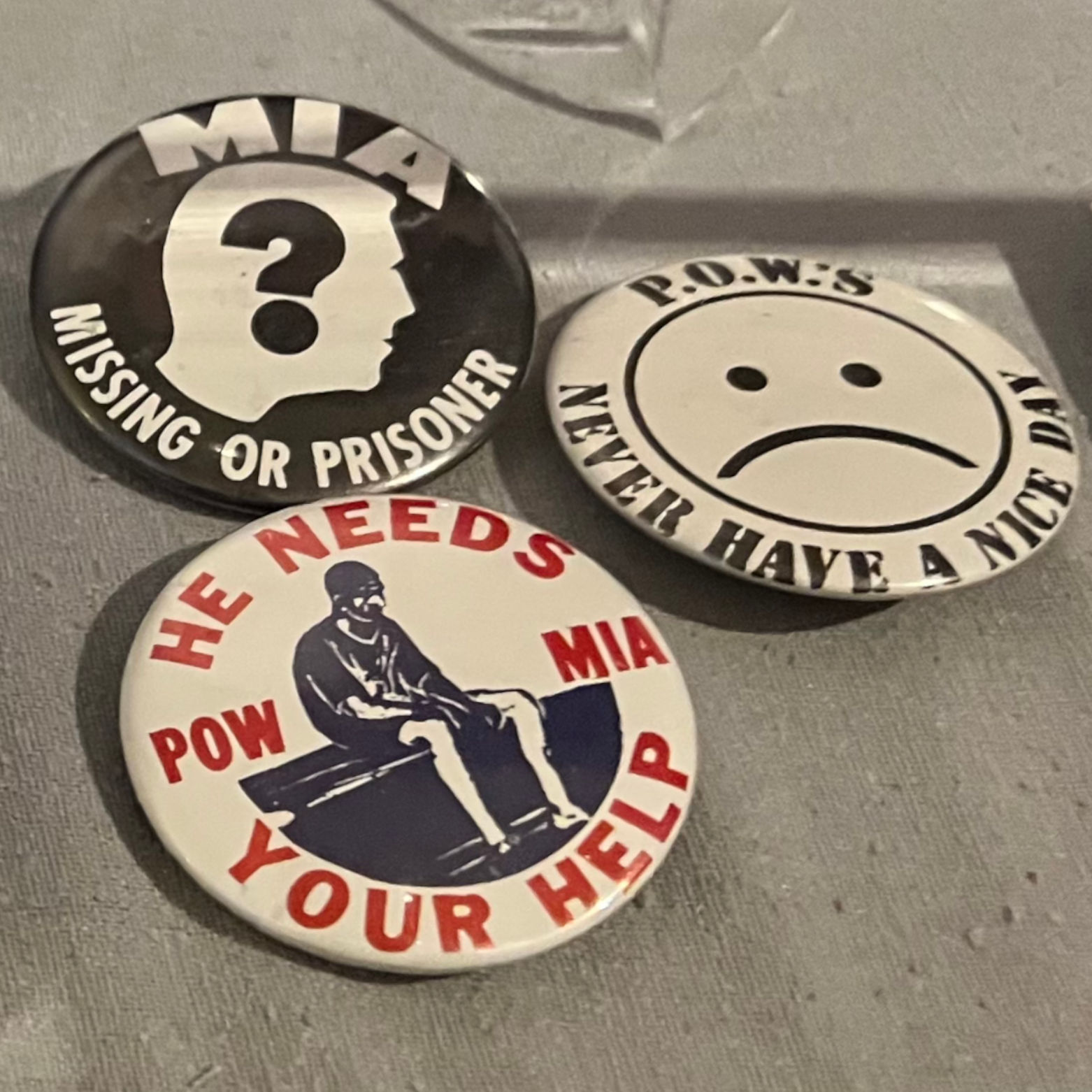
The Camps
Hell on Earth
13 Prisons
During the Vietnam War, 766 Americans are known to have been held as prisoners of war. Over the course of the war, North Vietnam operated 13 prisons. The POWs were held there in deplorable conditions, violating the Geneva Conventions.
In the camps, the POWs were subject to torture, held in isolation, denied proper medical care, given starvation rations, and subjected to constant abuse by their captors. The cells were small and poorly ventilated. The camps were overrun with rats, roaches, mosquitoes, and other vermin.
Most of the prisons were located in or near North Vietnam's capital, Hanoi.
President Nixon approved plans developed by the Department of Defense to liberate POWs at Son Tay, a prison 23 miles outside Hanoi. American forces launched the raid on November 20, 1970. They arrived at the camp at 2:18 in the morning. Unfortunately, the raiding party found the prison cells empty.
Although the raid did not rescue any POWs, it produced some positive results. An official U.S. Air Force history explains:
Despite rescuing no prisoners, the raid proved a success in other ways. It caused North Vietnam to gather POWs in fewer locations to prevent similar raids, making POW communication and organization easier. POW morale soared.
Later, one recalled that
The daring raid so close to Hanoi demonstrated that the U.S. had the will and means to carry out exceptional operations to ensure POW well-being.
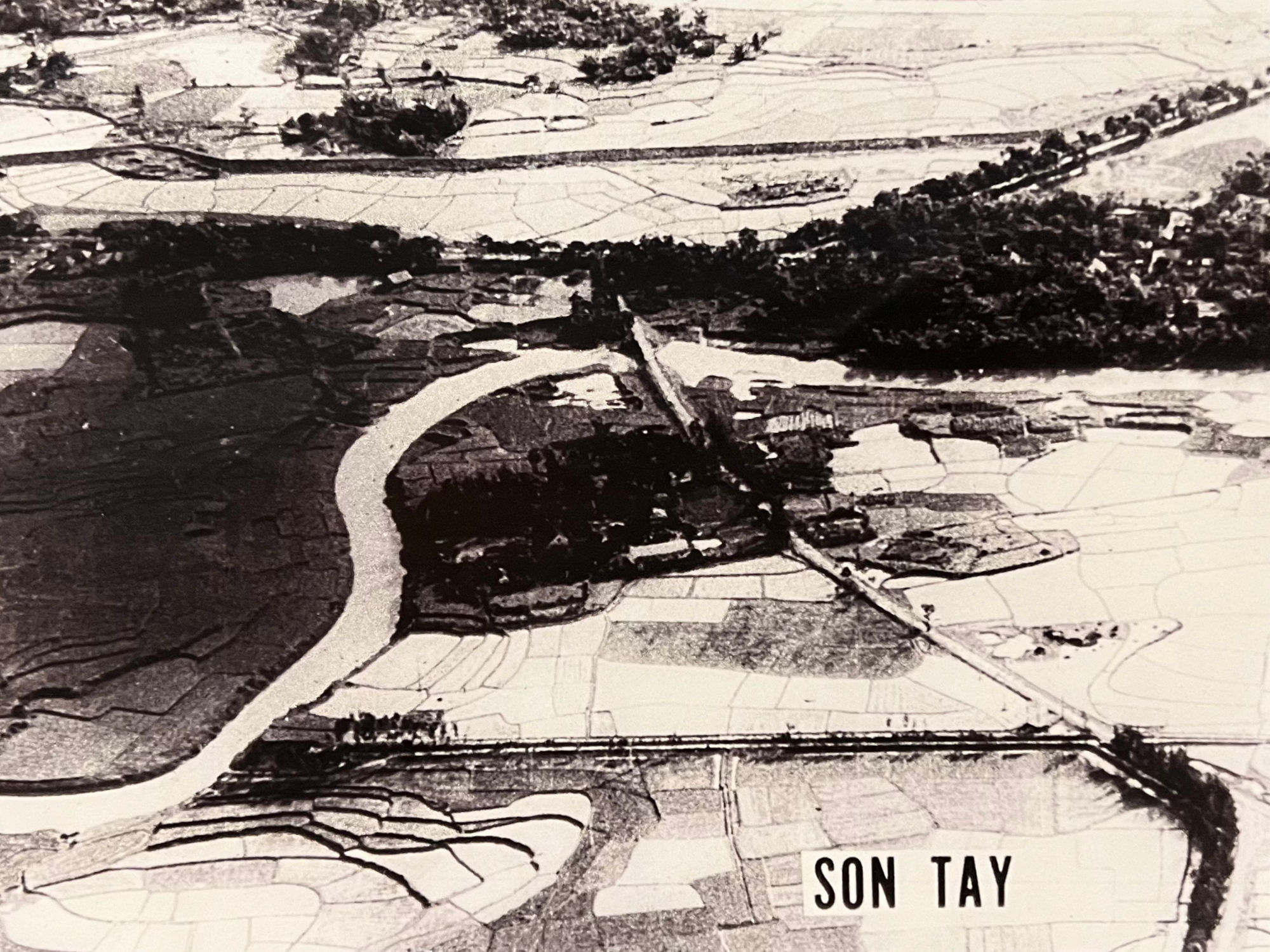
Son Tay
23 miles outside Hanoi
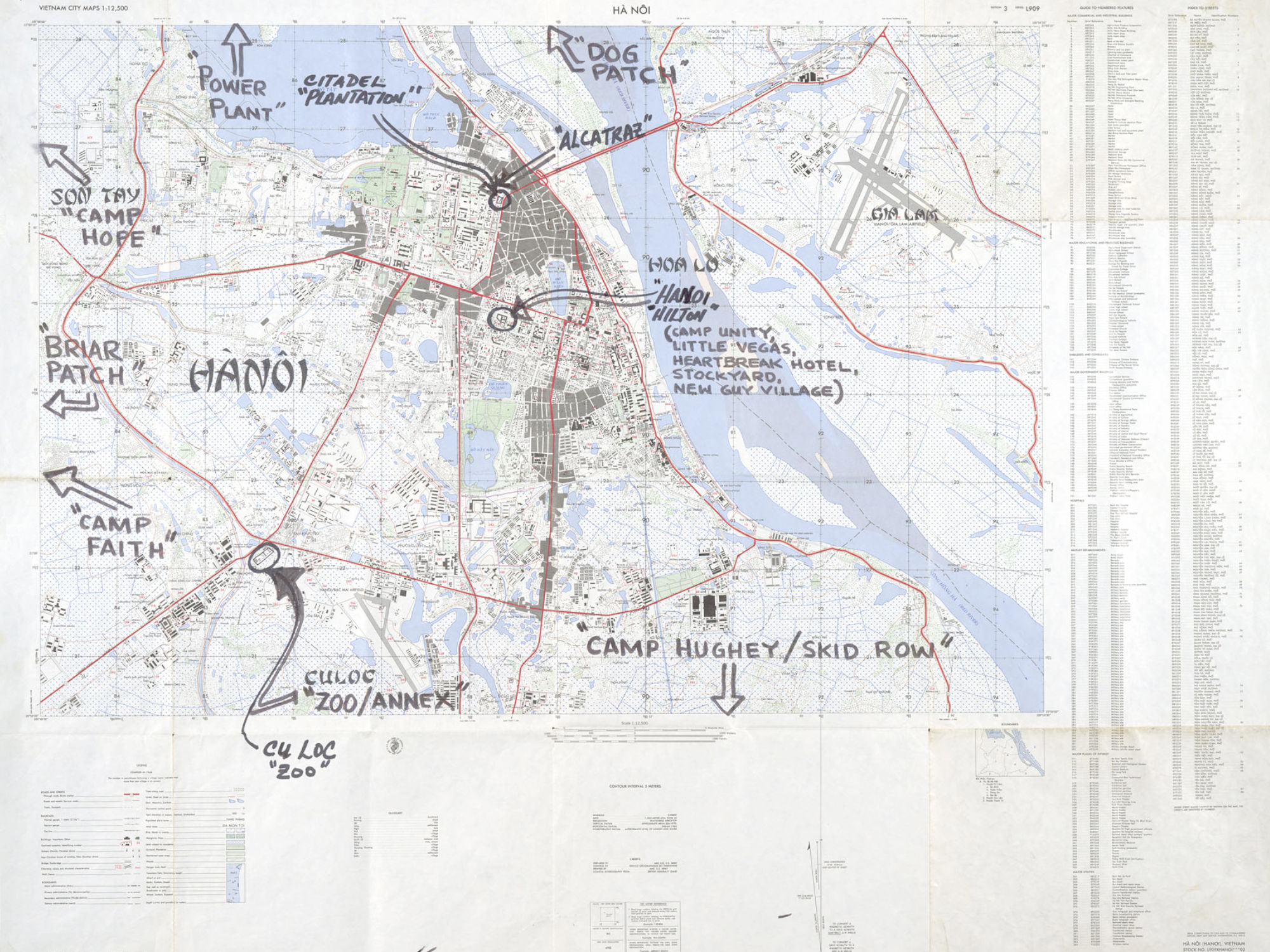
US intelligence aerial photographs showing prison camps that held POWs.
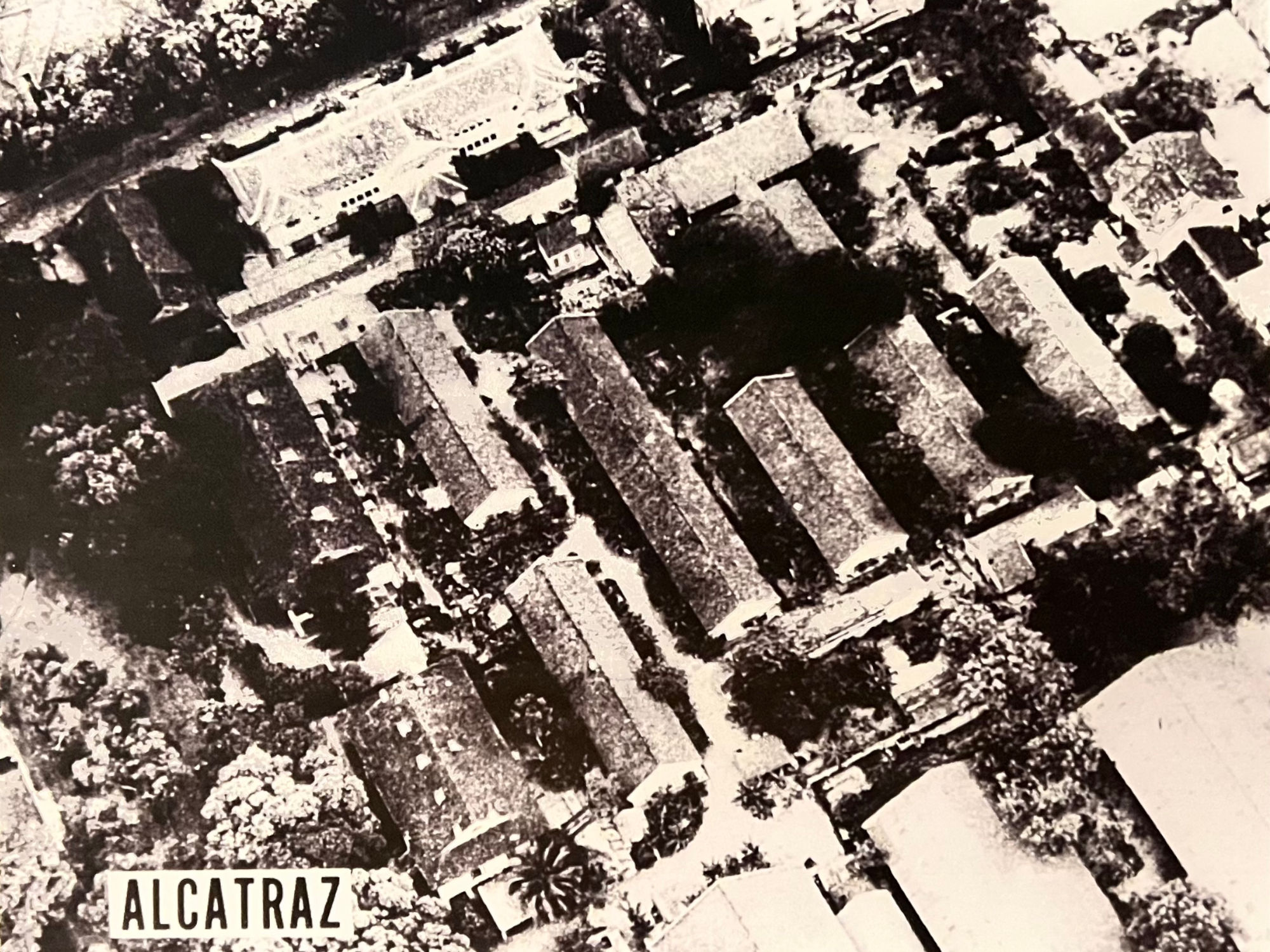
Vietnam Prison Camp
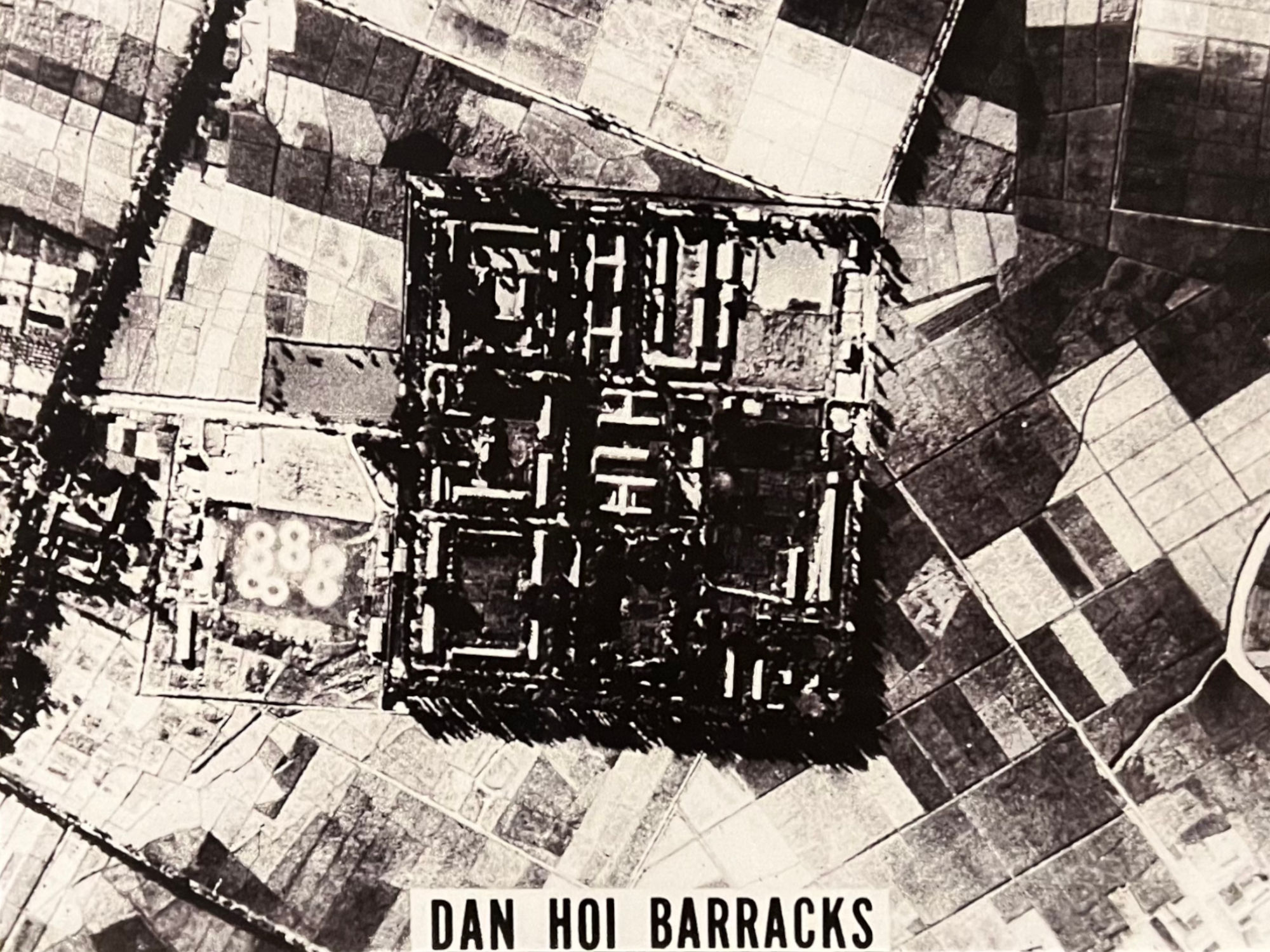
Vietnam Prison Camp
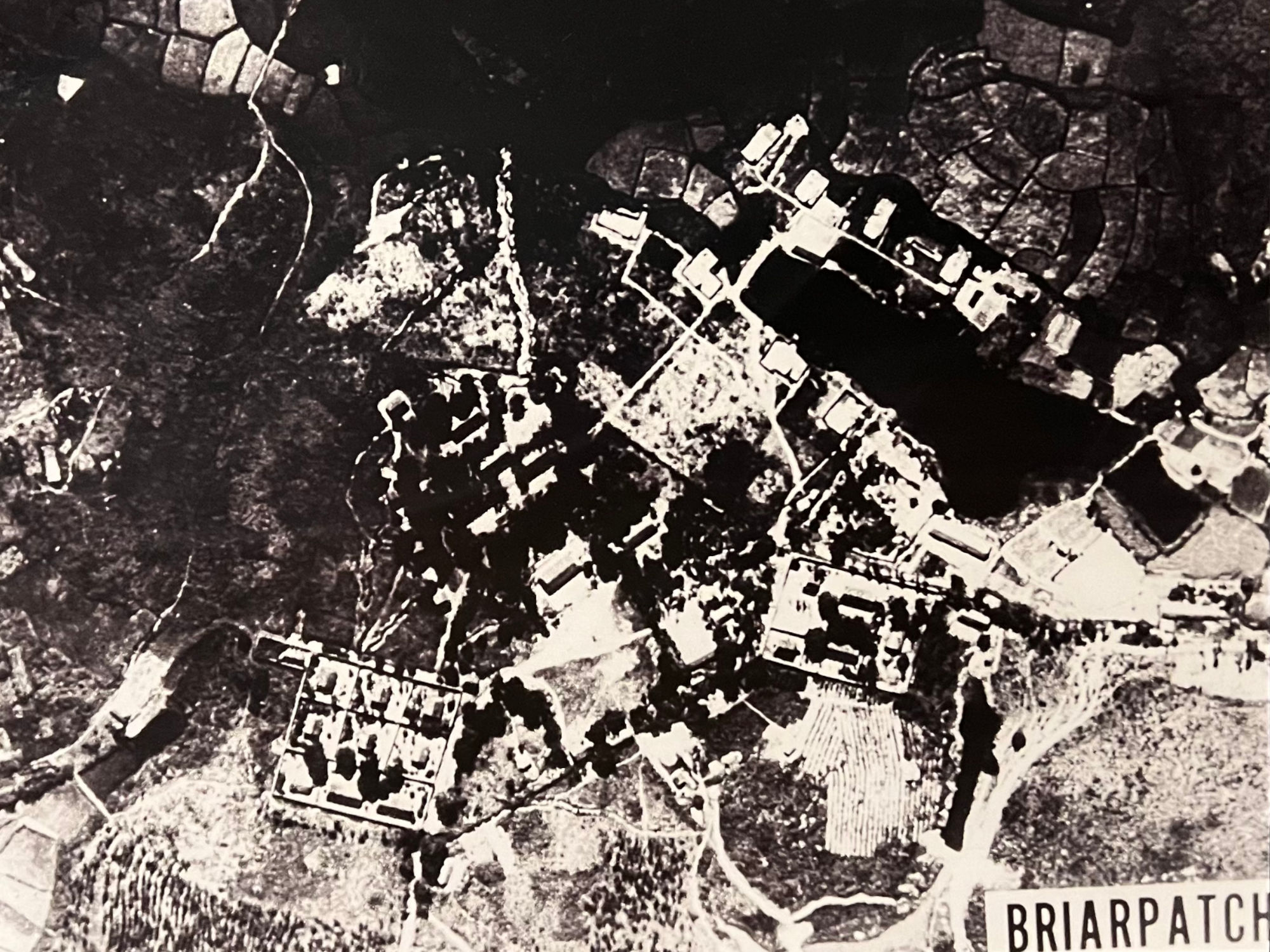
Vietnam Prison Camp
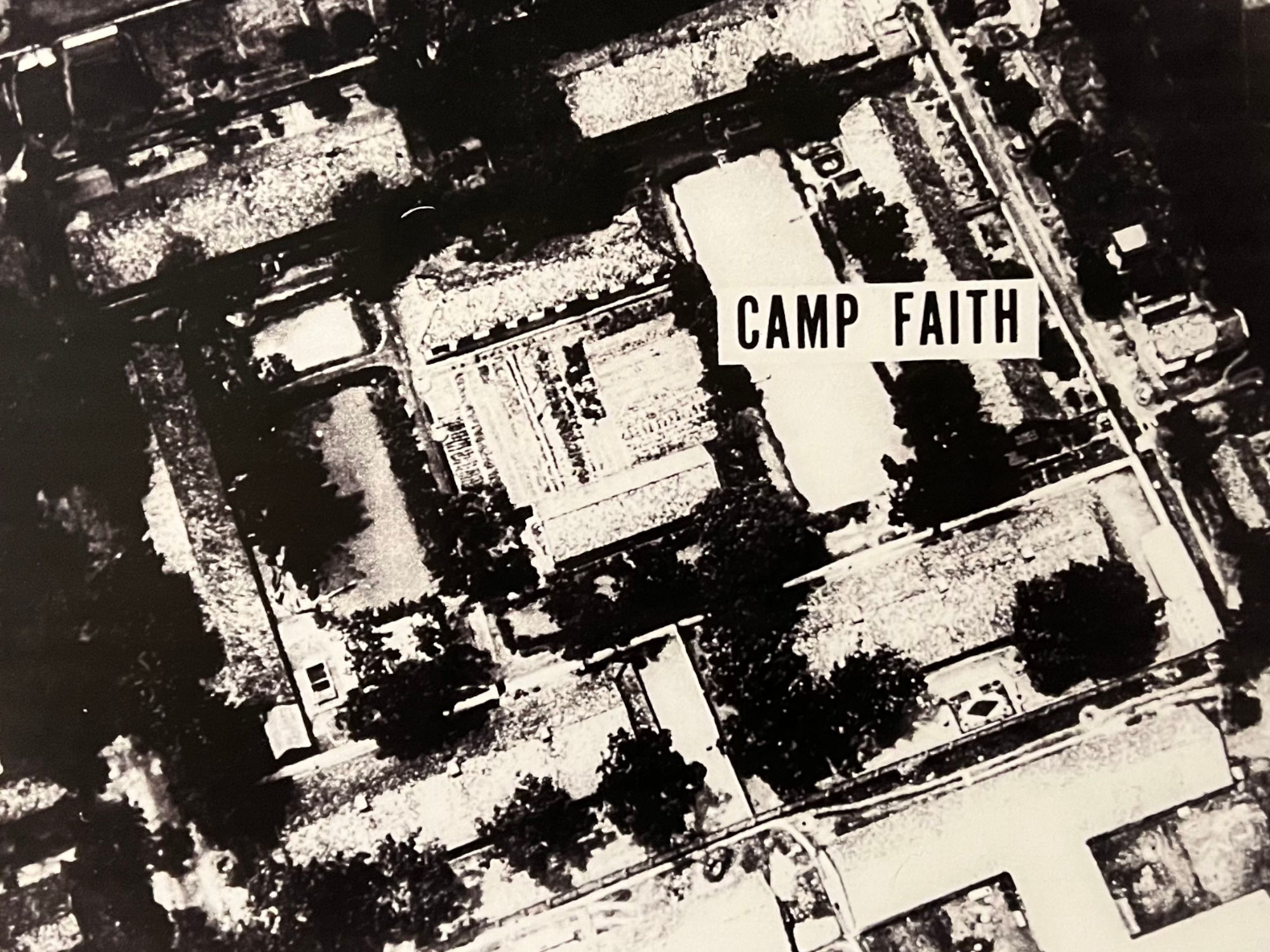
Vietnam Prison Camp
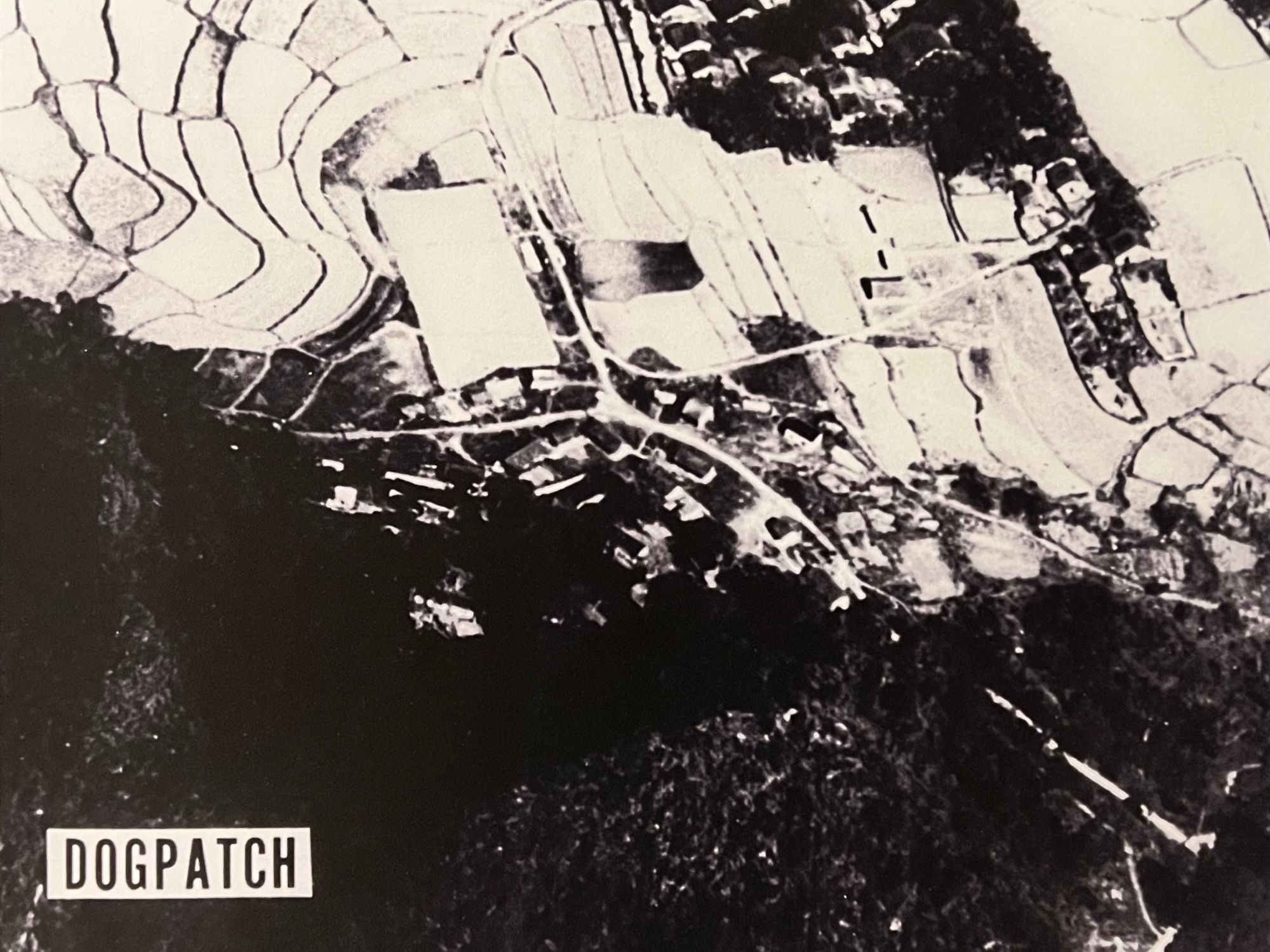
Vietnam Prison Camp
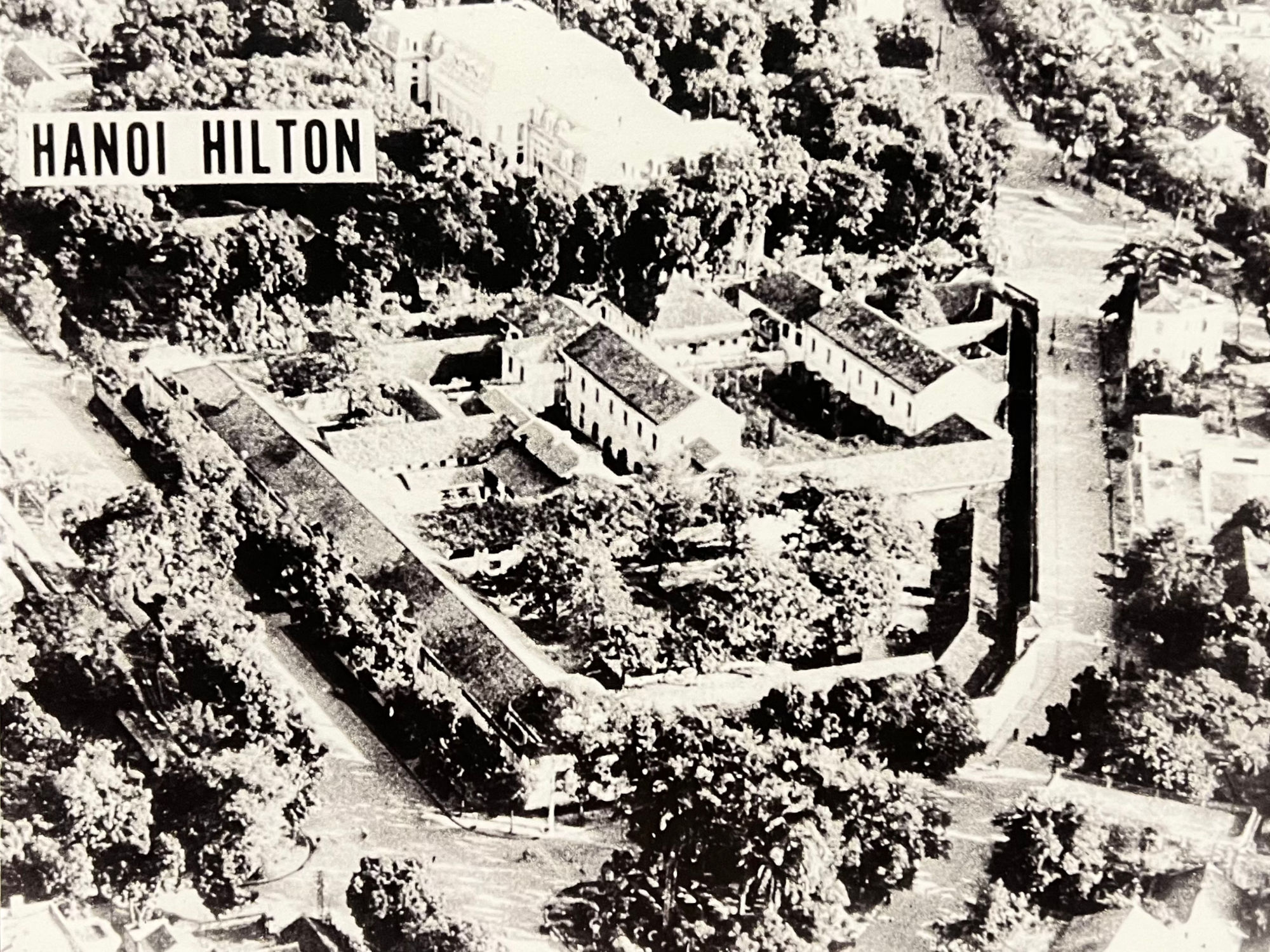
Vietnam Prison Camp
- Camp Unity
- Little Vegas
- Heartbreak Hotel
- Stockyard
- New Guy Village
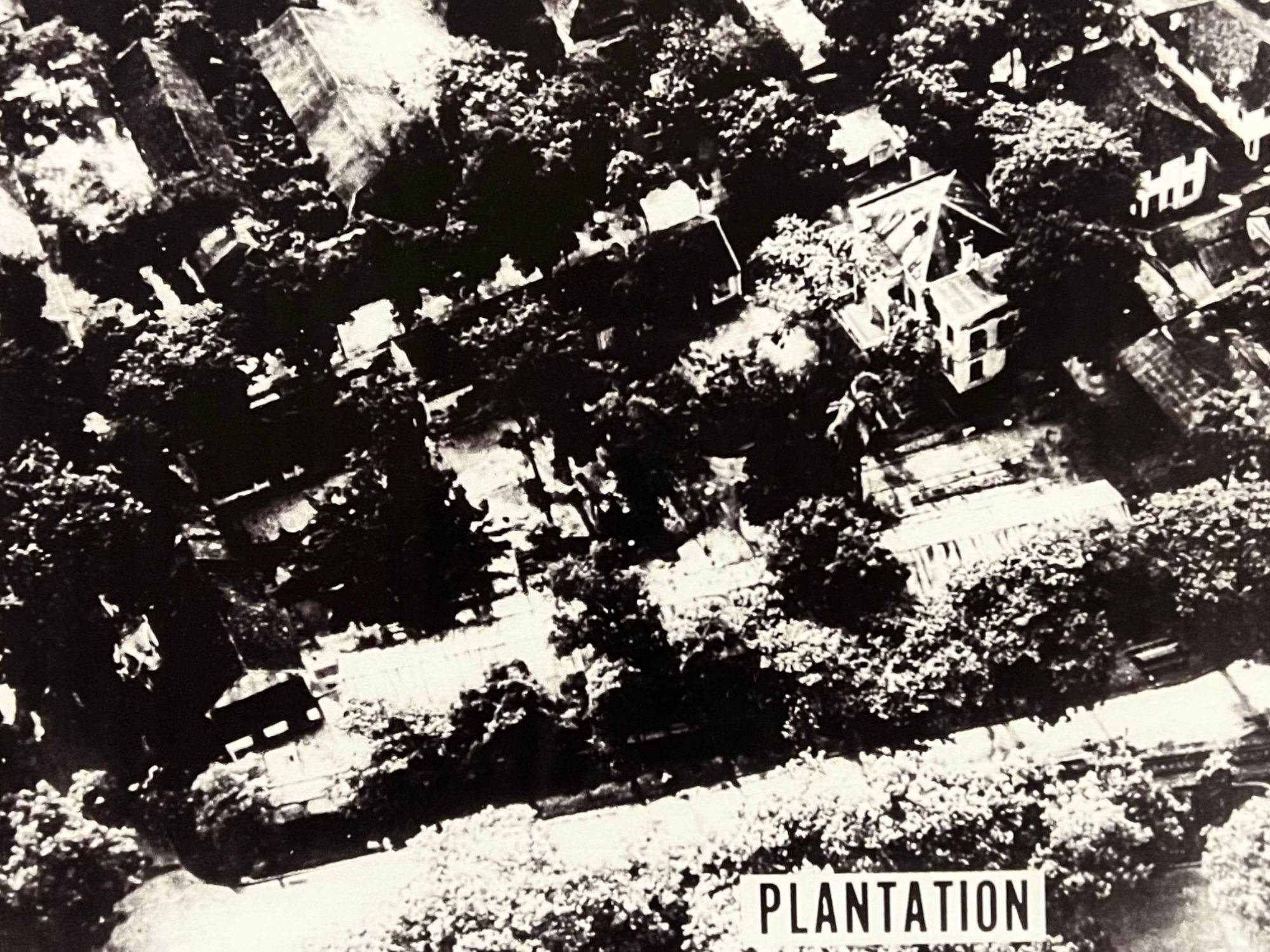
Vietnam Prison Camp
- Citadel
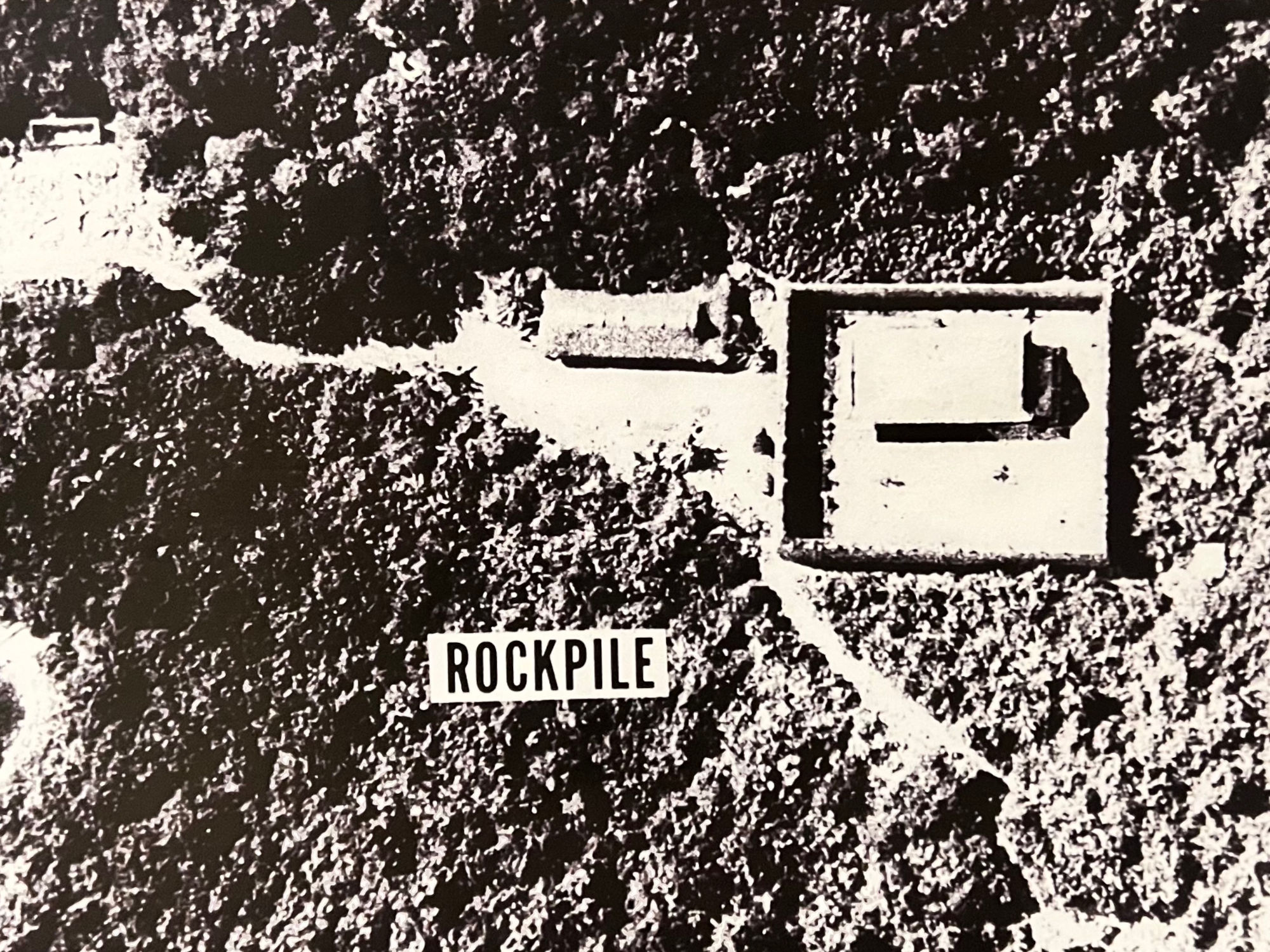
Vietnam Prison Camp
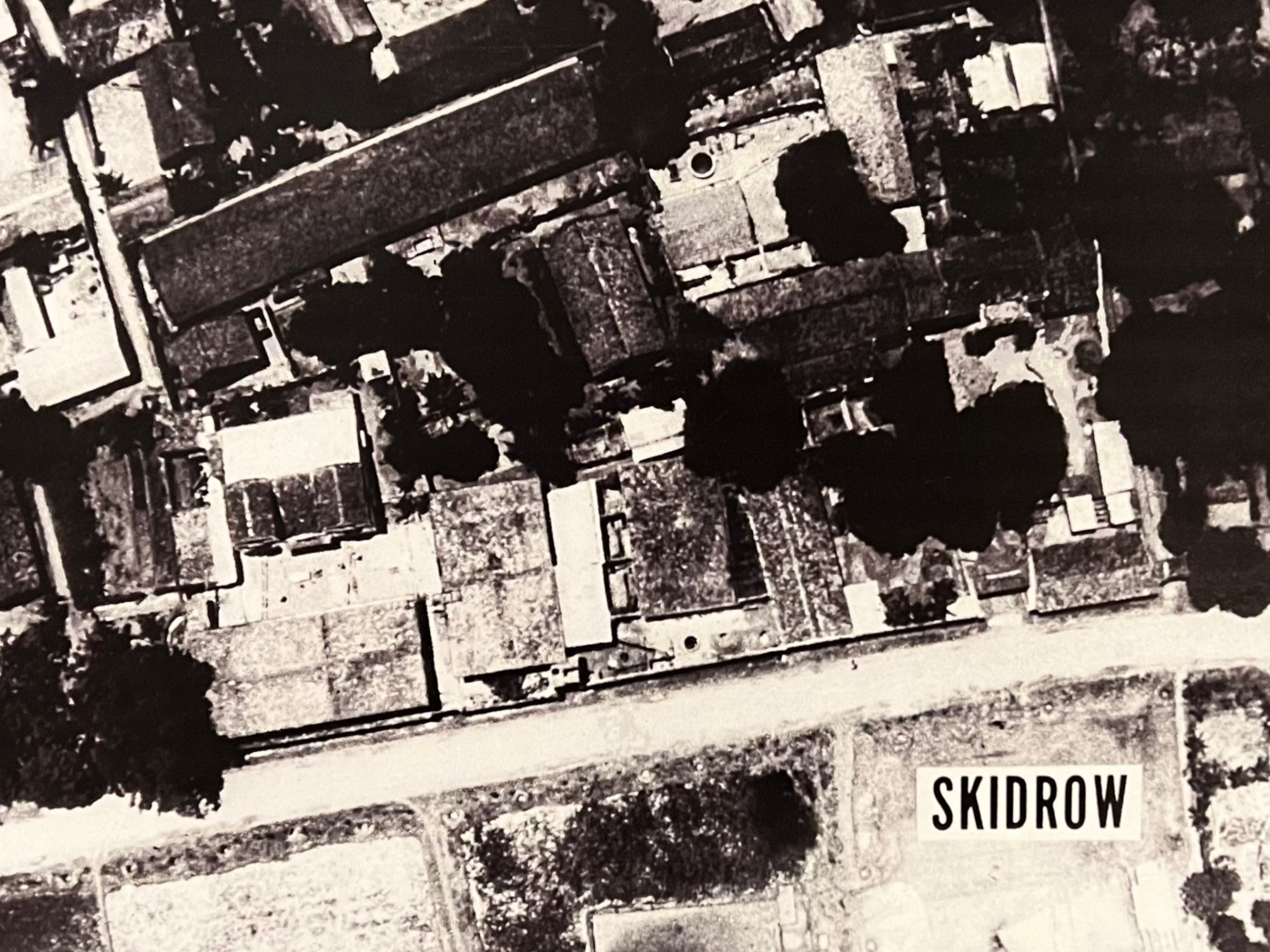
Vietnam Prison Camp
- Camp Hughey
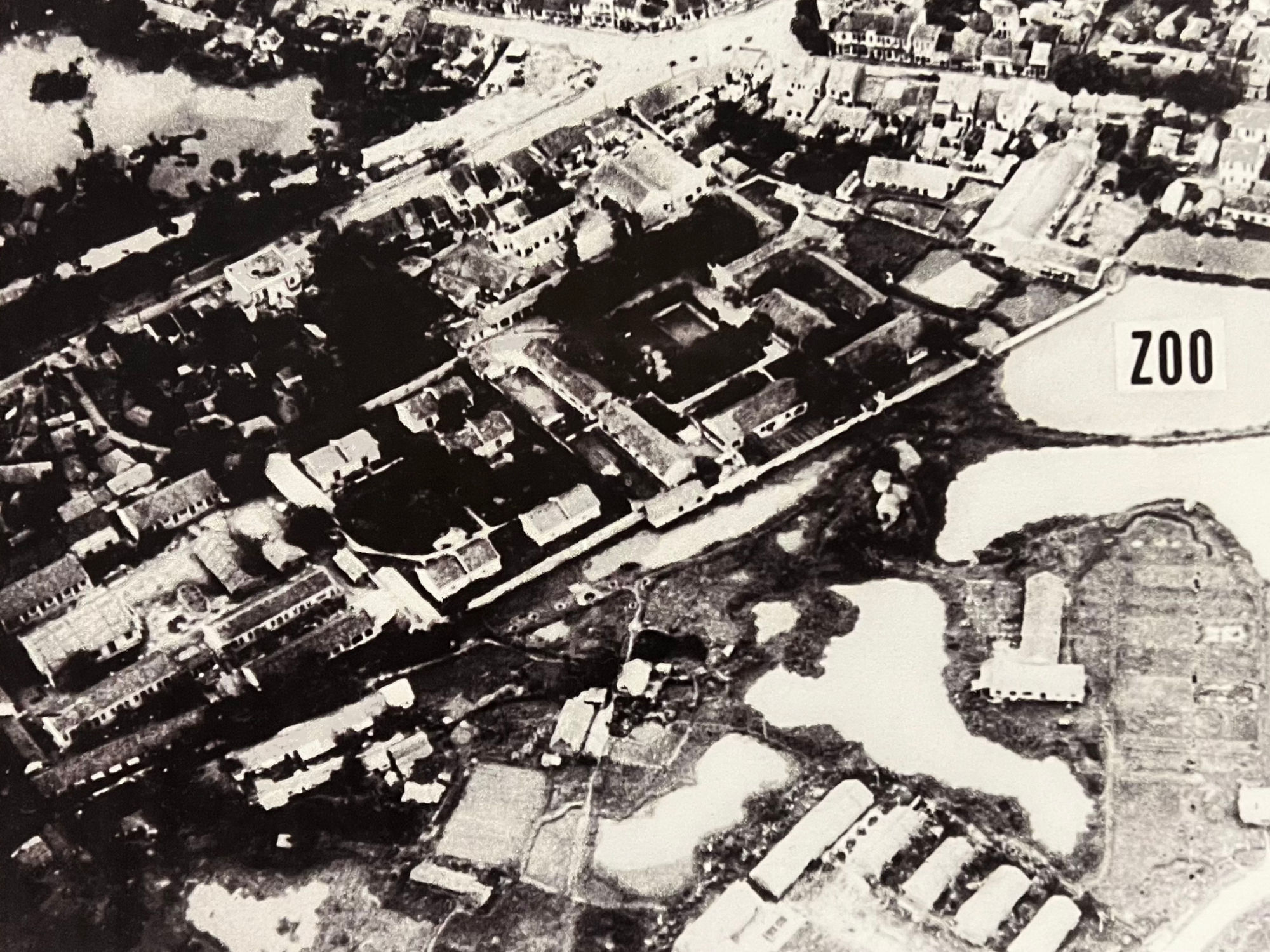
Vietnam Prison Camp
- Annex
POW / MIA Bracelets
America's Most Popular Piece of JewelryVoices In Vital America
If you were an American student in the early 1970s, you probably wore a bracelet bearing the name and rank of an American being held as a POW or MIA in Vietnam.
Carol Bates Brown and Kay Hunter were leaders of VIVA (Voices In Vital America), a student group from Los Angeles. The POW/MIA bracelets were the brainchild of these two young women attending UCLA.
Launched on Veterans Day 1970, nearly five million POW/MIA bracelets would be sold over the next six years. Priced at $2.50 - the average cost of a student movie ticket - the money helped pay for countless bumper stickers, buttons, and brochures to raise awareness and increase visibility of the POW/ MIA movement.
In addition to the millions of average Americans who wore the bracelets, celebrities including John Wayne, Bob Hope, Johnny Cash, Sonny Bono and Cher also showed support on their wrists.
Ms. Brown, the National Chairman of the POW/MIA bracelet campaign, recalled that VIVA
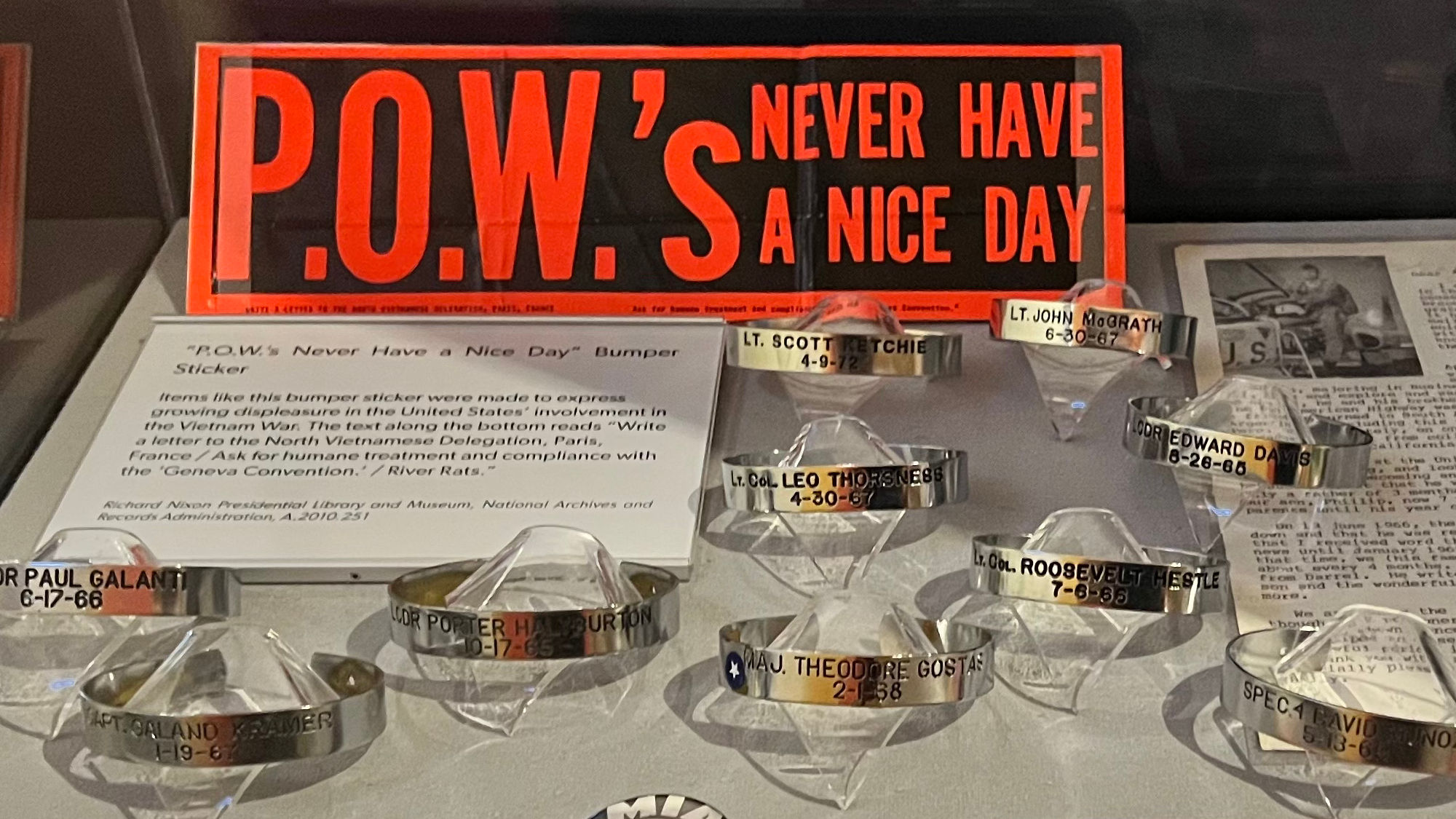
POW / MIA Bracelets
Voices in Vital America
POW/MIA bracelets were created and sold by Voices in Vital America (VIVA) as a way to raise awareness about American soldiers missing, imprisoned, or unaccounted for in the Vietnam War.
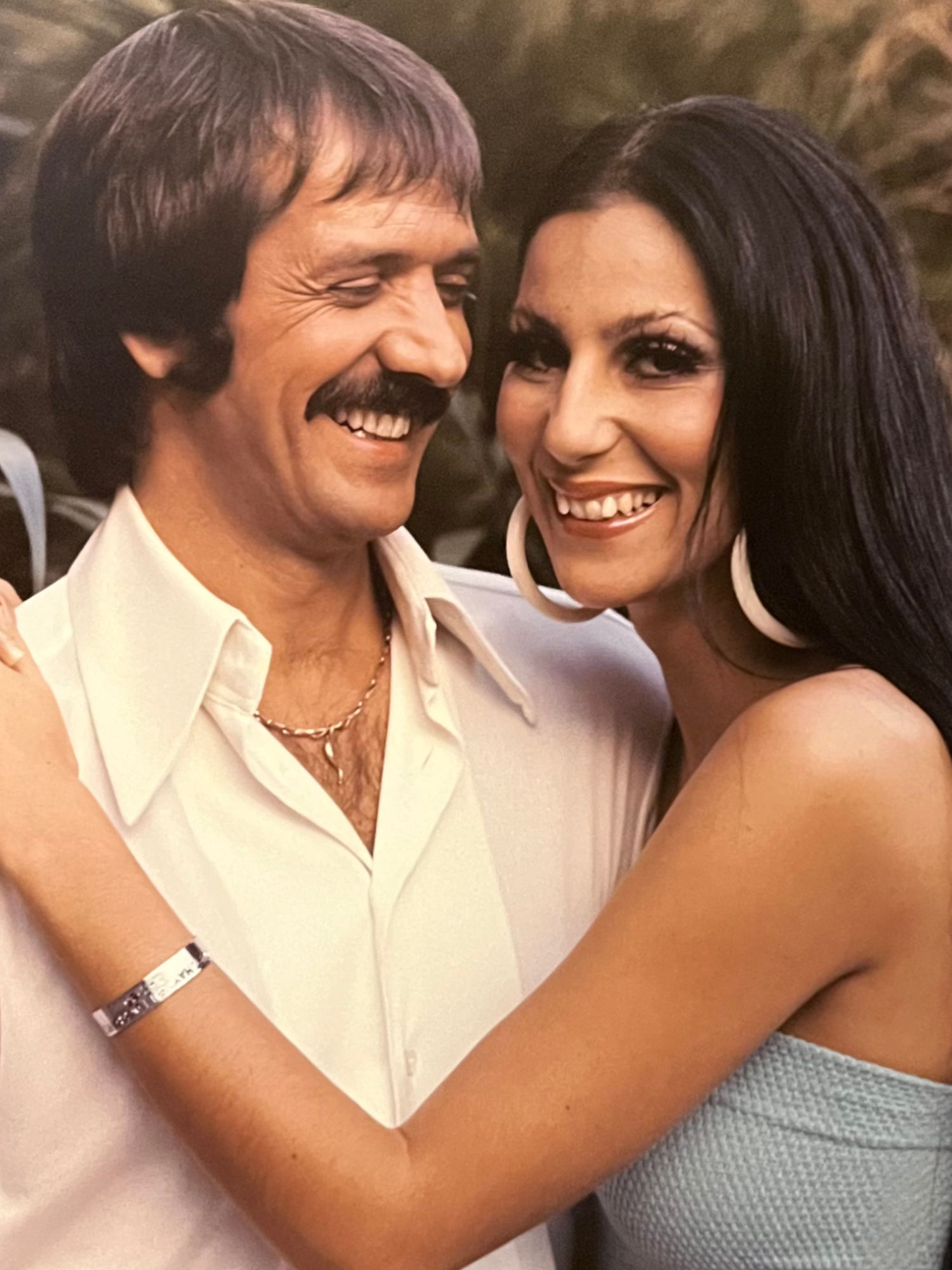
Sonny and Cher
POW/MIA Bracelets
Popular entertainers Sonny Bono and Cher, major advocates for the POWs, could often be seen sporting POW/MIA bracelets
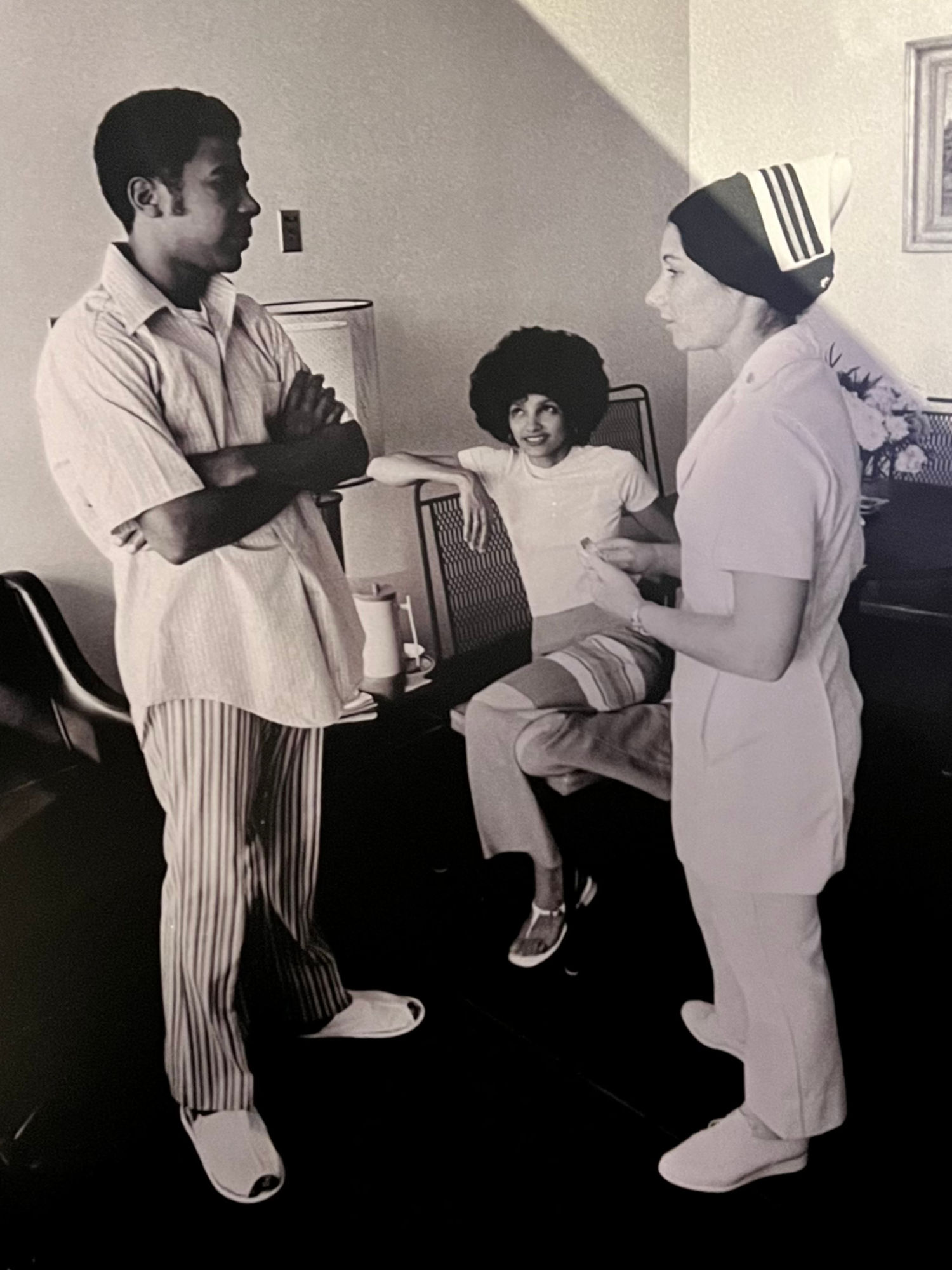
Norris Charles
POW/MIA Bracelets
Lieutenant Naval nurse Patricia Anderson had worn a bracelet bearing the name of Lieutenant Junior Grade Norris Charles. She presents her bracelet to Charles upon his return home.
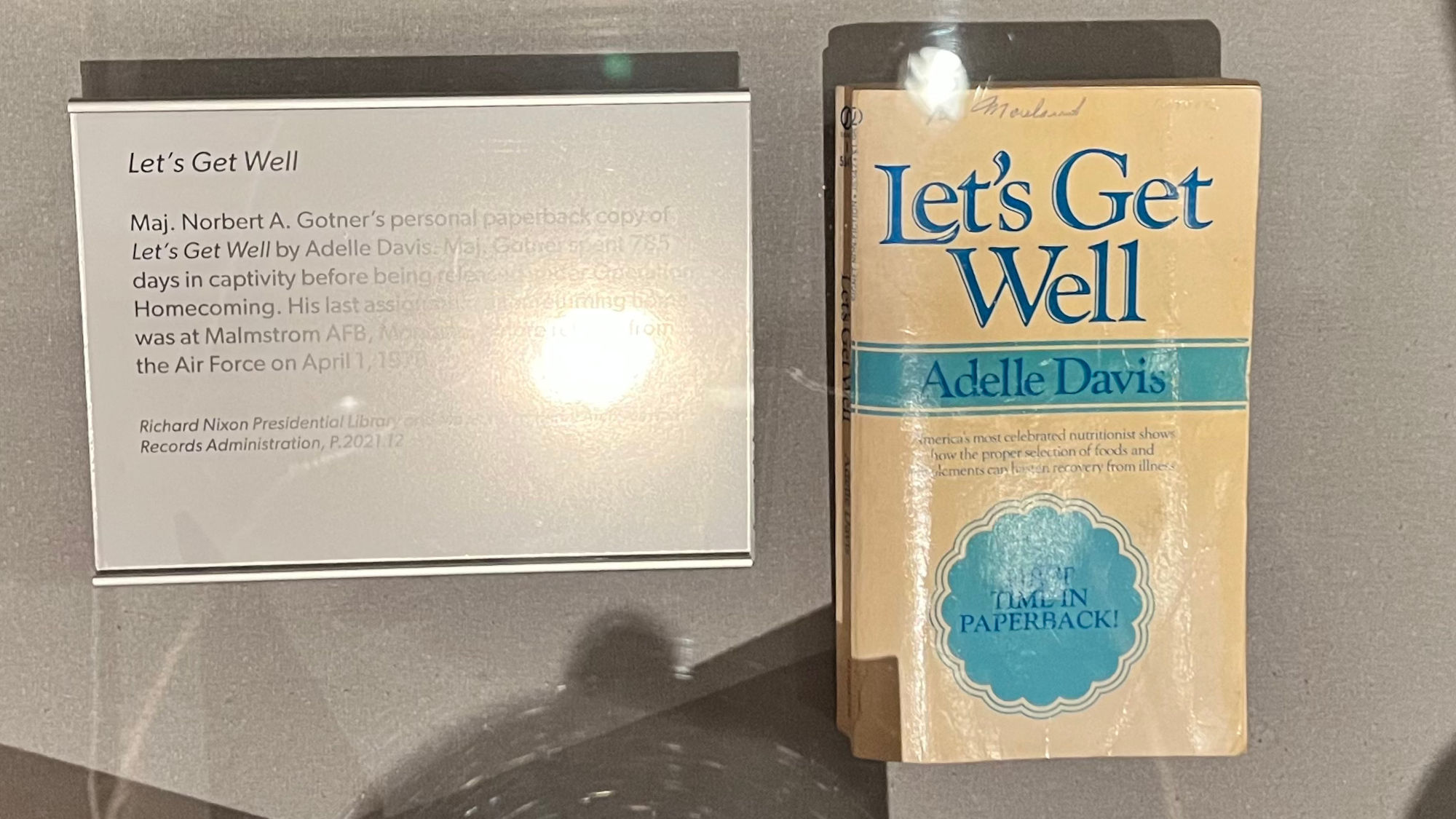
Norbert A. Gotner
Let's Get Well by Adelle Davis
Major Norbert A. Gotner's personal paperback copy of Let's Get Well by Adelle Davis. Major Gotner spent 785 days in captivity before being released under Operation Homecoming. His last assignment after returning home was at Malmstrom AFB, Montana, before retiring from the Air Force on April 1, 1978.
- Taken Prisoner on February 3, 1971 after being forced to eject over Laos
RELATED: [https://www.amazon.com/dp/1638230889]
Write Hanoi:
Help the POWs Home
Among the many grassroots efforts to raise awareness for American POWs in Vietnam was the "Write Hanoi" letter campaign. Hundreds of thousands of people wrote to the North Vietnamese government urging them to follow the Geneva Conventions.
Write Hanoi spread across the country. In Colorado Springs, 125,000 letters were penned. In Waco, Texas, more than 48,000 people wrote letters and signed petitions. Booths soliciting letters were set up outside stores in St. Petersburg, Florida. In North Carolina, more than 300,000 letters were collected. Congress passed a resolution supporting the Write Hanoi campaign.
One of the most successful Write Hanoi campaigns was led by Phyllis Galanti. Her husband, Lieutenant Commander Paul Galanti, was shot down on June 17, 1966. In February 1971, she launched the letter writing campaign in her hometown of Richmond, Virginia.
Mrs. Galanti's efforts resulted in 452,000 letters to the North Vietnamese government. Later that year she traveled to Stockholm, Sweden, and delivered the letters to North Vietnam's ambassador. Her trip generated international attention to the suffering of the POWs.
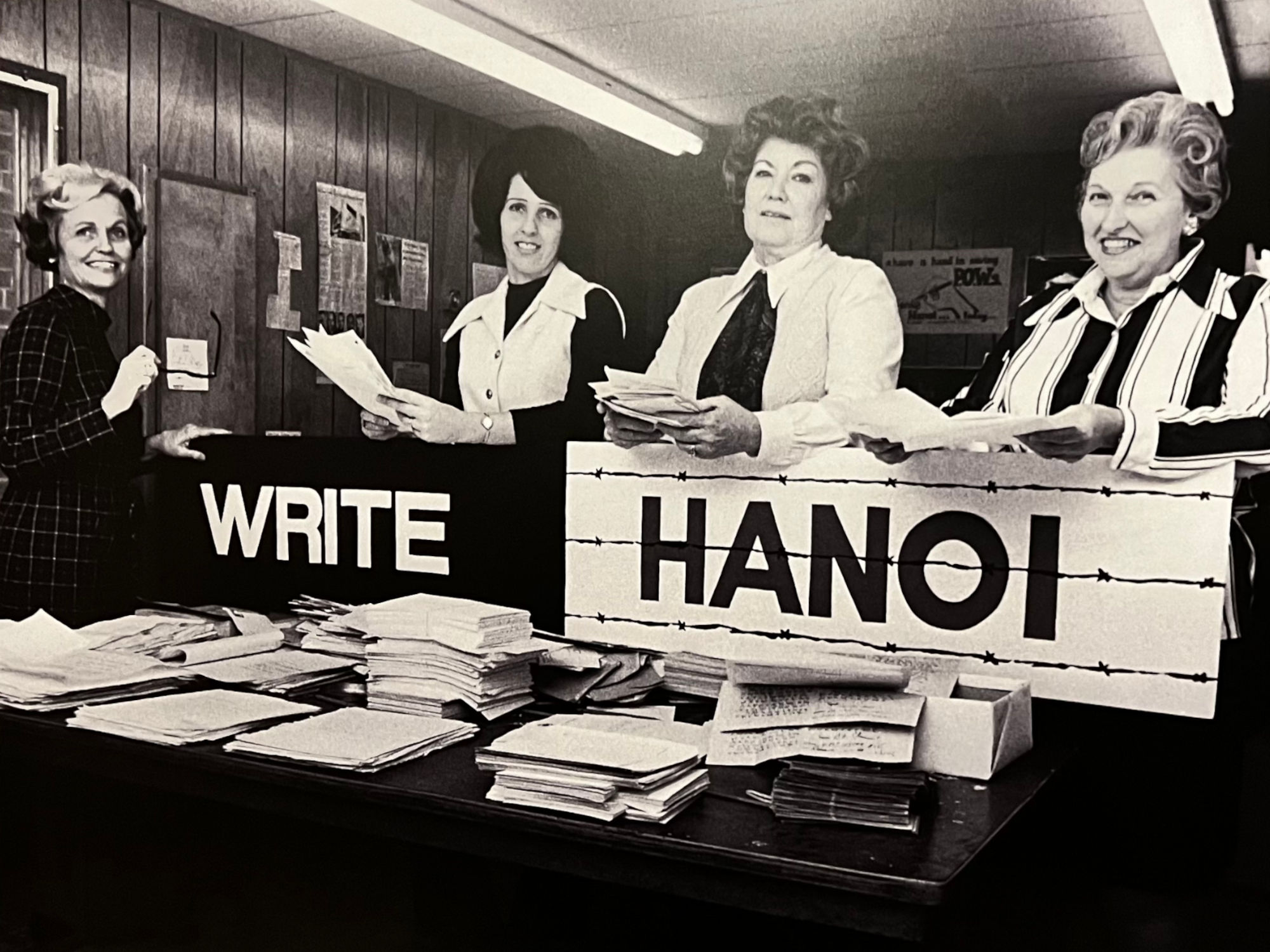
Protest Letters
Write Hanoi
The letter writing movement spread across the country, with thousands of letters pouring in to be sent to the government of North Vietnam.
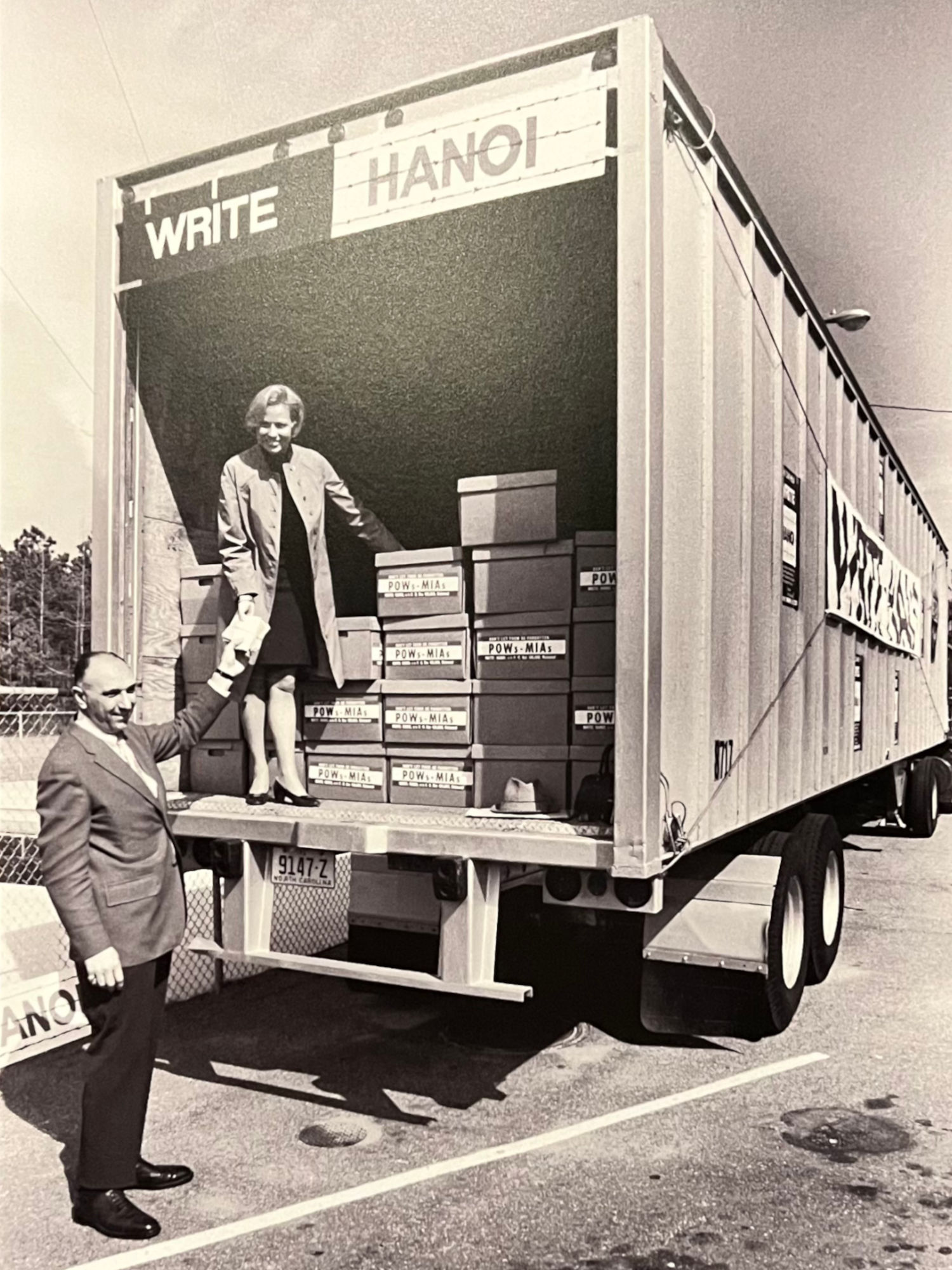
Protest Letters
Write Hanoi
Thousands of letters from wives, family members, and concerned Americans were written to the government of North Vietnam in protest of the treatment and continued captivity of the POWs.
Live from Space:
Apollo 14 Remembers America's POW/MIAAlan Shepard, a Naval aviator, was the first American in space and the fifth American to walk on the Moon. Commander of the three-man Apollo 14 crew, Shepard's time on the lunar surface is best remembered for an extraterrestrial golf shot. Using an improvised six iron, Shepard hit what may be the longest drive in the history of golf.
Less remembered, but no less memorable, was the February 6, 1971 televised appeal he made on behalf of America's POWs and MIAs in Vietnam as Apollo 14 returned from the moon:
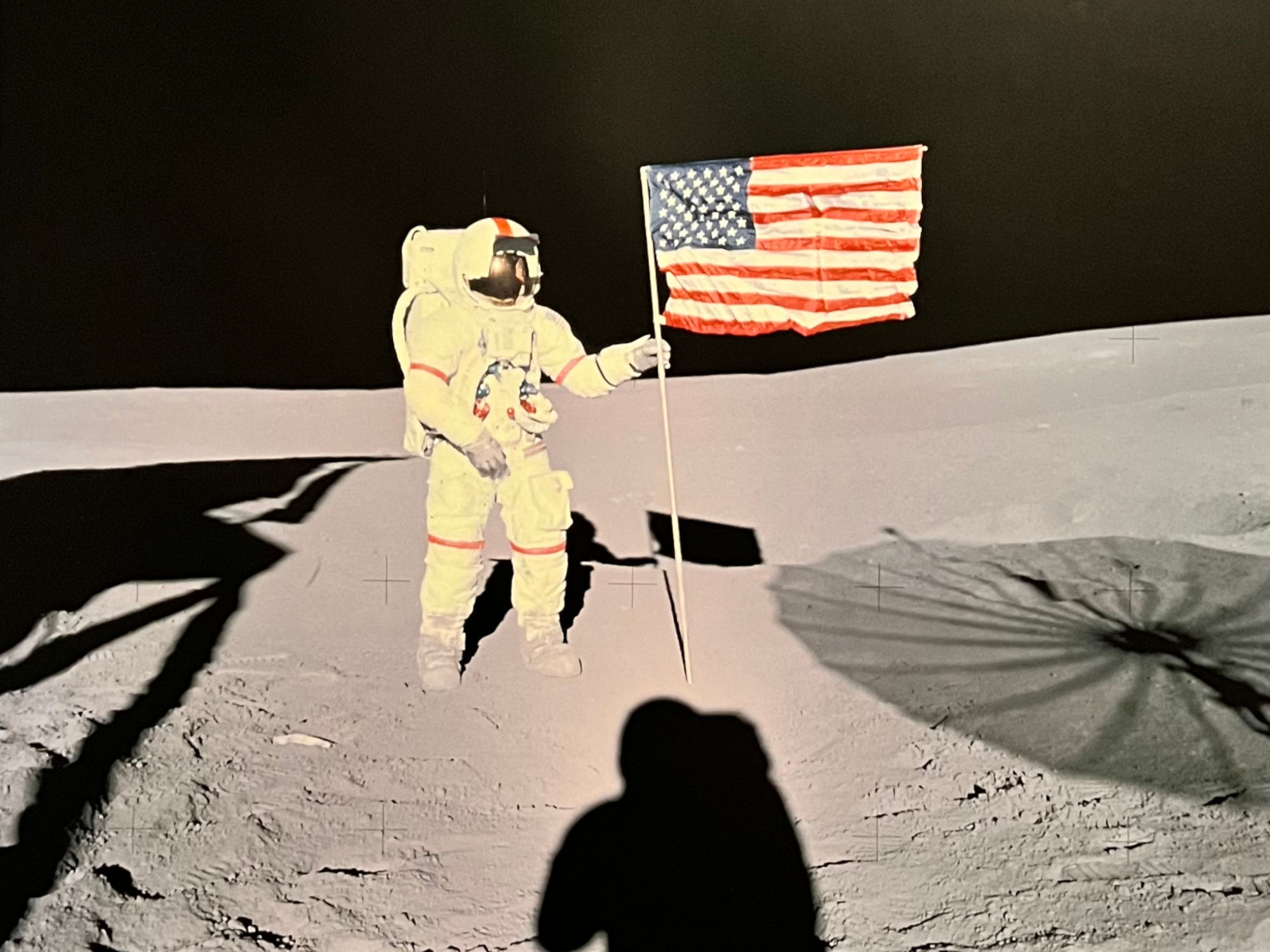
Alan Shepard
Apollo 14
Alan Shepard of the Apollo 14 lunar landing mission standing on the Moon's surface, holding an American Flag.
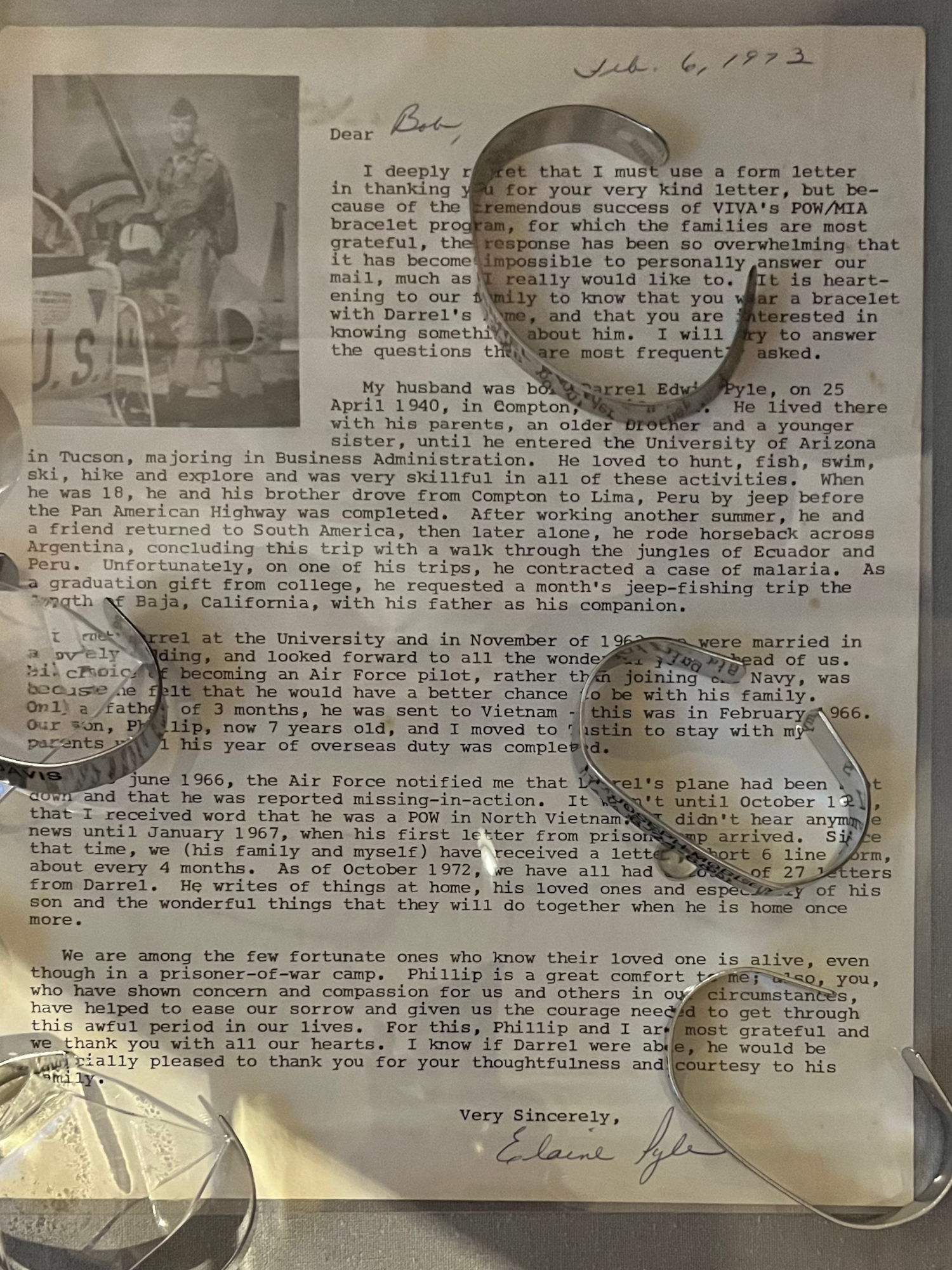
Darrell Edwin Pyle
POW / MIA Bracelets
- POW Shot down June 1966
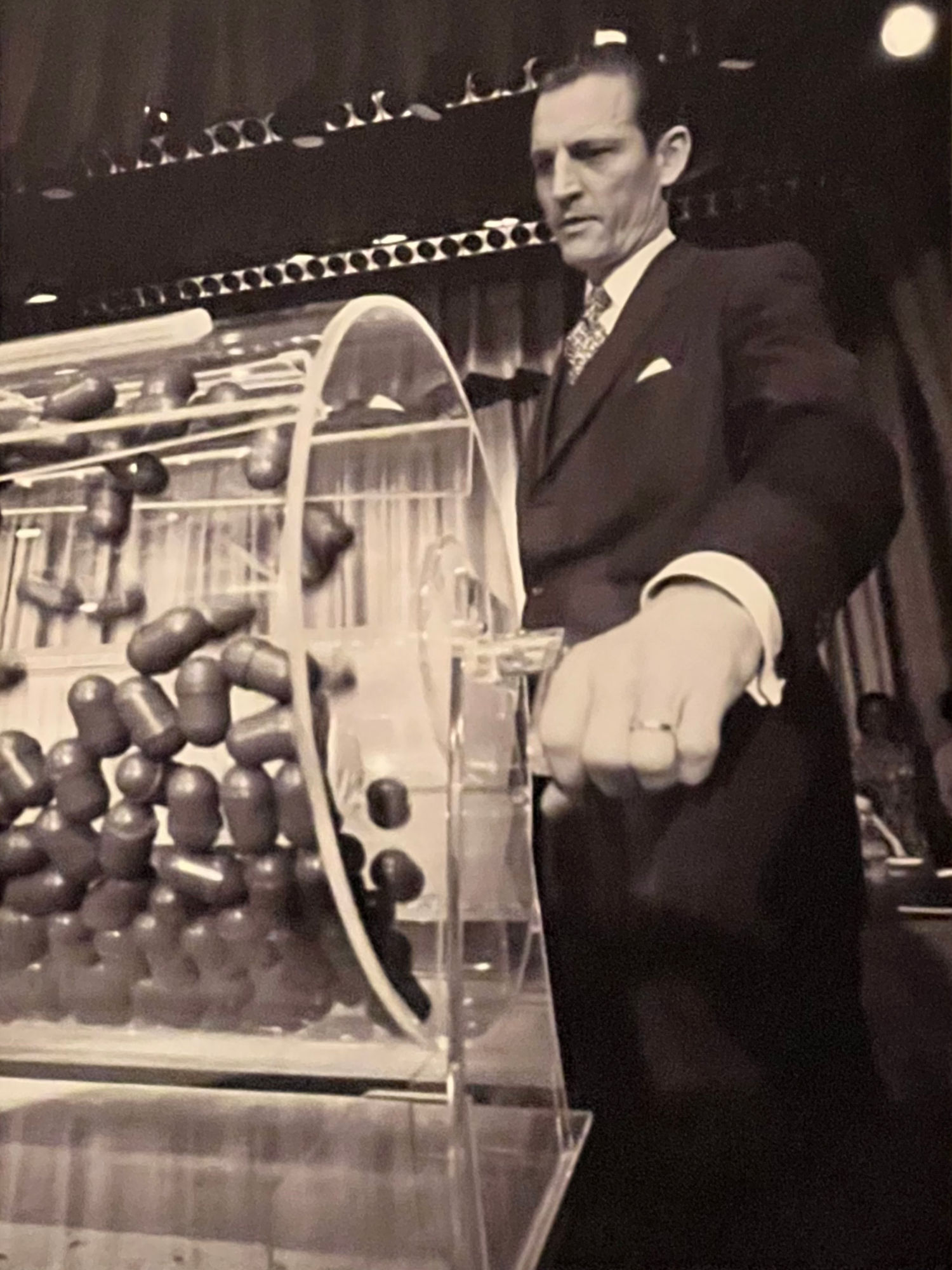
Annual Draft Lottery
Washington, D.C
Curtis Tarr, Director of the Selective Service System, turns the drum containing capsules of draft numbers at the annual draft lottery in 1972.
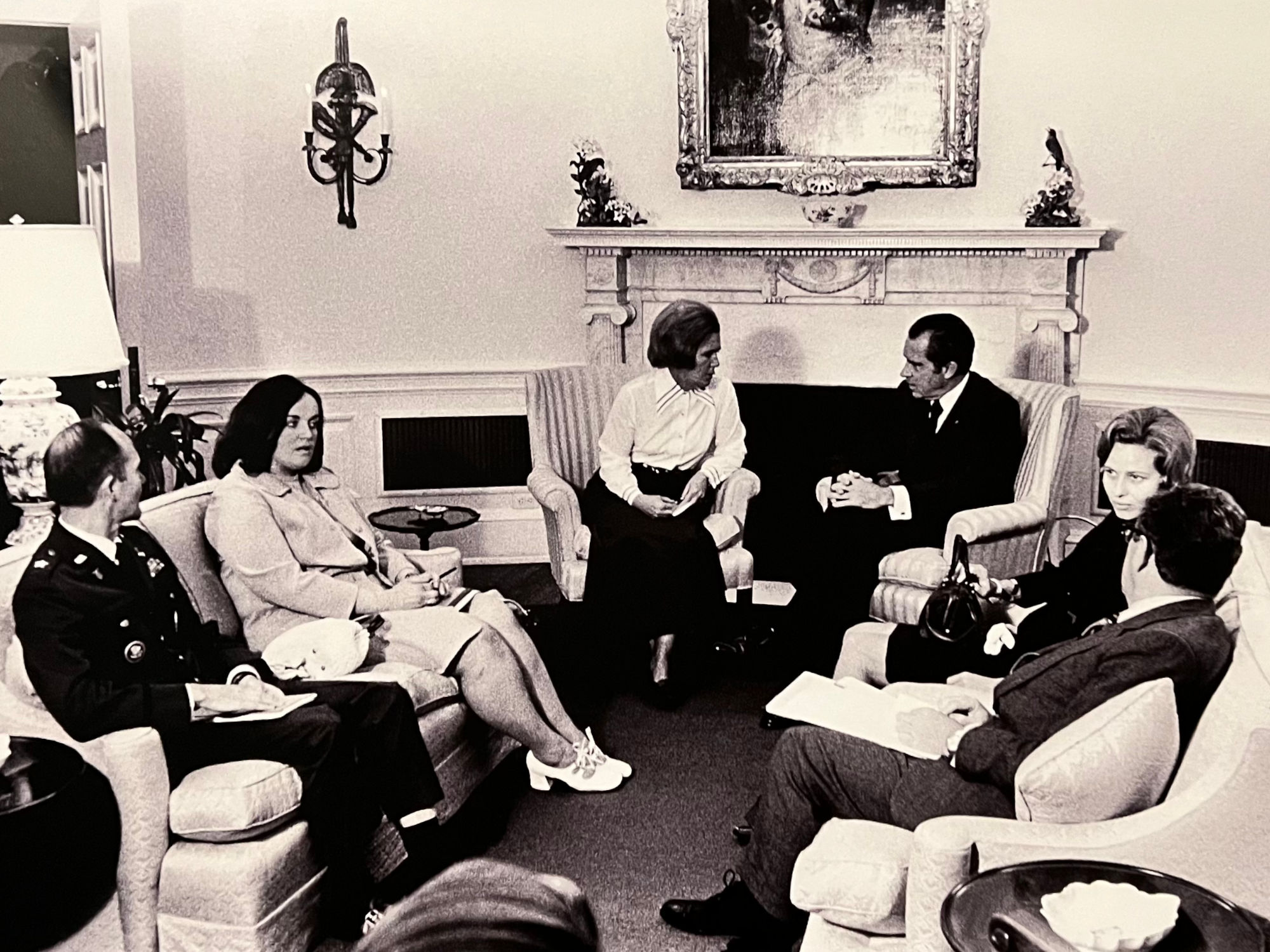
National League of POW/MIA Families
General Brent Scowcroft, President Nixon, and National Security Advisor Henry Kissinger, meet in the Oval Office with POW wives representing the National League of Families of American Prisoners and Missing in Southeast Asia.
- Maureen Dunn
- Sybil Stockdale
- Phyllis Galanti
The Air War in Vietnam
President Nixon ordered the bombing of North Vietnam to resume. To disrupt enemy supply lines to South Vietnam, Nixon also ordered bombing of the "Ho Chi Minh Trail" through Cambodia. The enemy was using neutral Cambodia to move soldiers and supplies to South Vietnam.
Two major bombing campaigns against targets in North Vietnam occurred during the Nixon administration.
- Operation Linebacker, initiated in May 1972
Targeted strategically important enemy facilities. When peace talks seemed to be reaching a successful conclusion, President Nixon ended Operation Linebacker on October 23, 1972. - Operation Linebacker II, initiated in December 1972
Talks with the North Vietnamese bogged down. President Nixon renewed heavy bombing of North Vietnam. Beginning on December 18, 1972, Operation Linebacker II continued until December 29, with a 24-hour truce on Christmas.
Operation Linebacker II
It appeared the United States, South Vietnam, North Vietnam, and the Viet Cong were getting close to concluding an agreement that would end the Vietnam War. With the end in sight, achieving final approval by all four parties was proving difficult.
As November unfolded, negotiations bogged down. By early December, the possibility of an agreement was slipping away. The North Vietnamese presented new demands the United States could not accept and withdrew some provisions to which it had previously agreed. According to President Nixon, Hanoi's chief negotiator Le Duc Tho,
...made it clear that he had no intention of reaching an agreement.
The following day, to bring the North back to the negotiating table, President Nixon ordered renewed bombing of North Vietnam. Beginning December 18, heavy aerial attacks on strategic targets in Hanoi and Haiphong - North Vietnam's major port - inflicted massive damage. The assault continued through December 29, except for Christmas Day, when the President ordered a 24-hour truce.
On December 30, the North agreed to resume talks.
President Nixon received heavy criticism both at home and abroad for the December bombings. But at the Hanoi Hilton, the response was jubilation.
It's a B-52 raid.... Pack your bags. We're going home
POW Harry Jenkins shouted to his fellow captives.
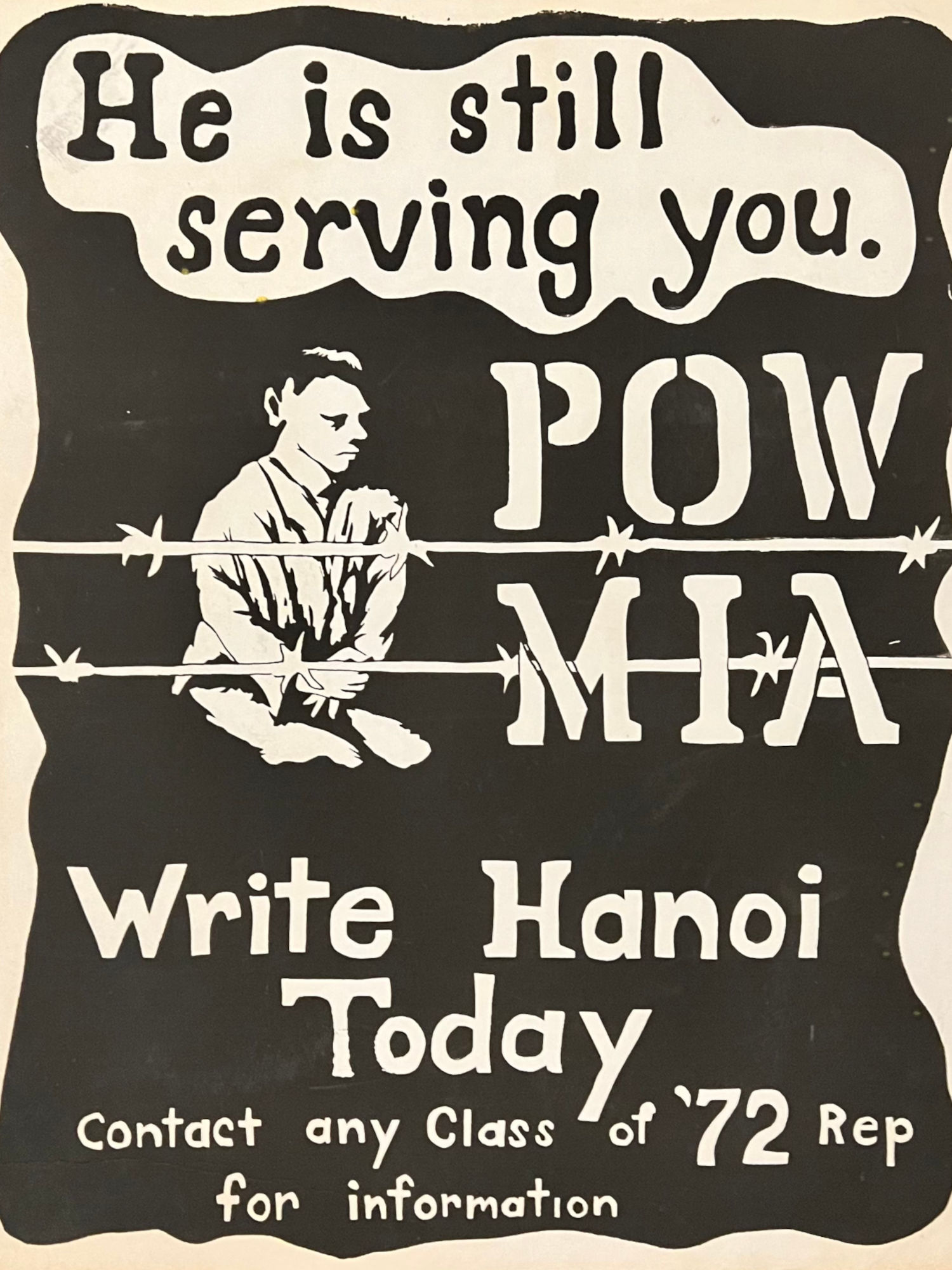
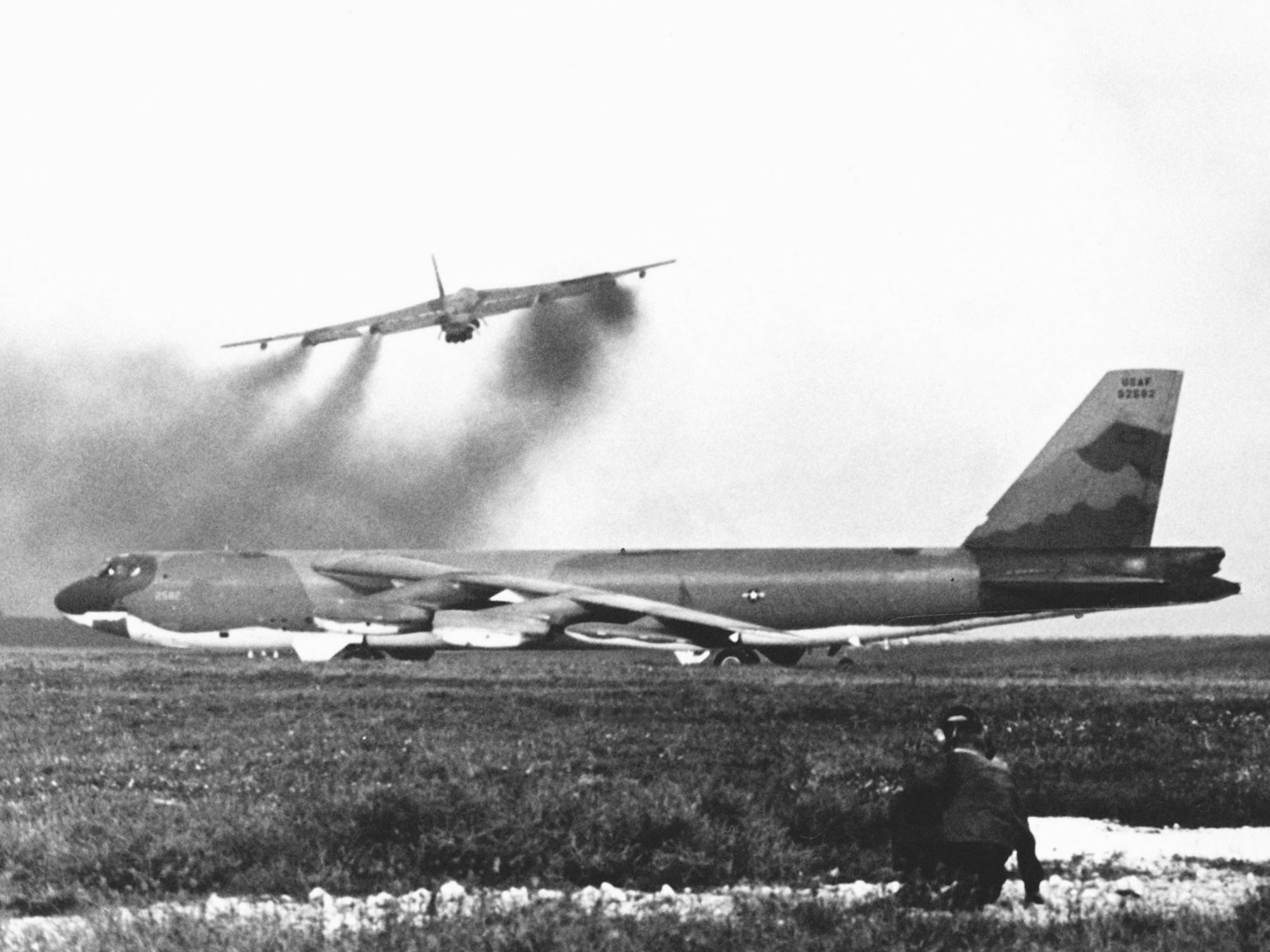
B-52 Stratofortress
Andersen Air Force Base, Guam (USA)
One U.S. Air Force Boeing B-52G-125-BW Stratofortress from the 72nd Strategic Wing waiting, while another B-52 takes off for a mission bombing North Vietnam.
Operation Linebacker kicked off a new level of bombing against the North Vietnamese, featuring 24 hour strikes by B-52 Stratofortress. This round-the-clock operation was unprecedented in warfare.
Those Who Fought
All-Volunteer Military
President Nixon ended the draft in January 1973, creating an all-volunteer military. No men or women have been drafted into the armed forces since.
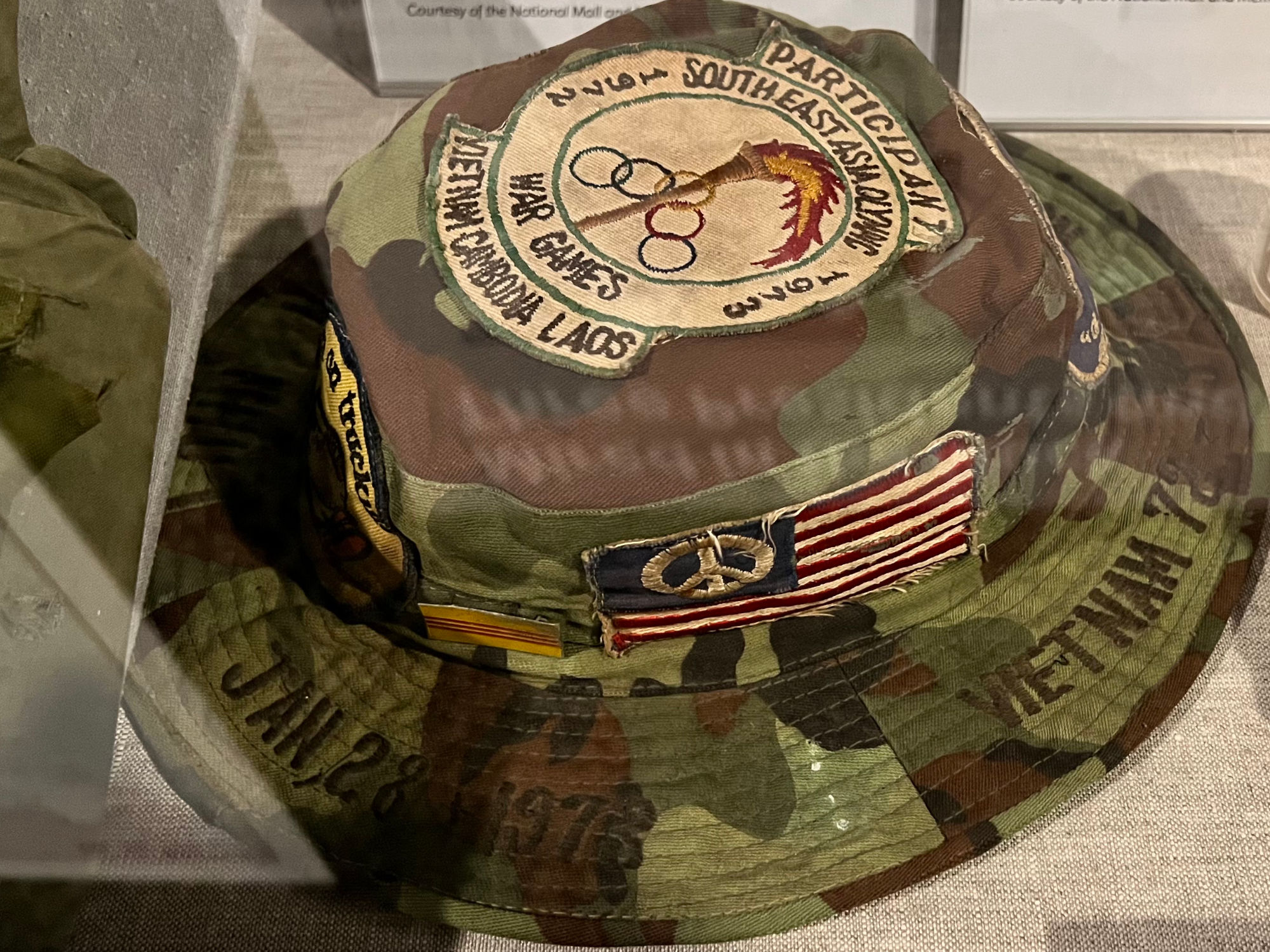
Jungle Hat
Tan Son Nhut AFB near Saigon
Camouflage boonie hat adorned with nine patches and pins with "Viet Nam 72-73, Nov 19, 1972, Tan Son Nhut, Jan 28, 1973" stitched around the brim.
Tan Son Nhut was a Republic of Vietnam air force base located near the southern Vietnamese city of Saigon. During the Vietnam War, the United States used Tan Son Nhut as a major operations center and posted Air Force, Army, Marine, and Navy units on the base.
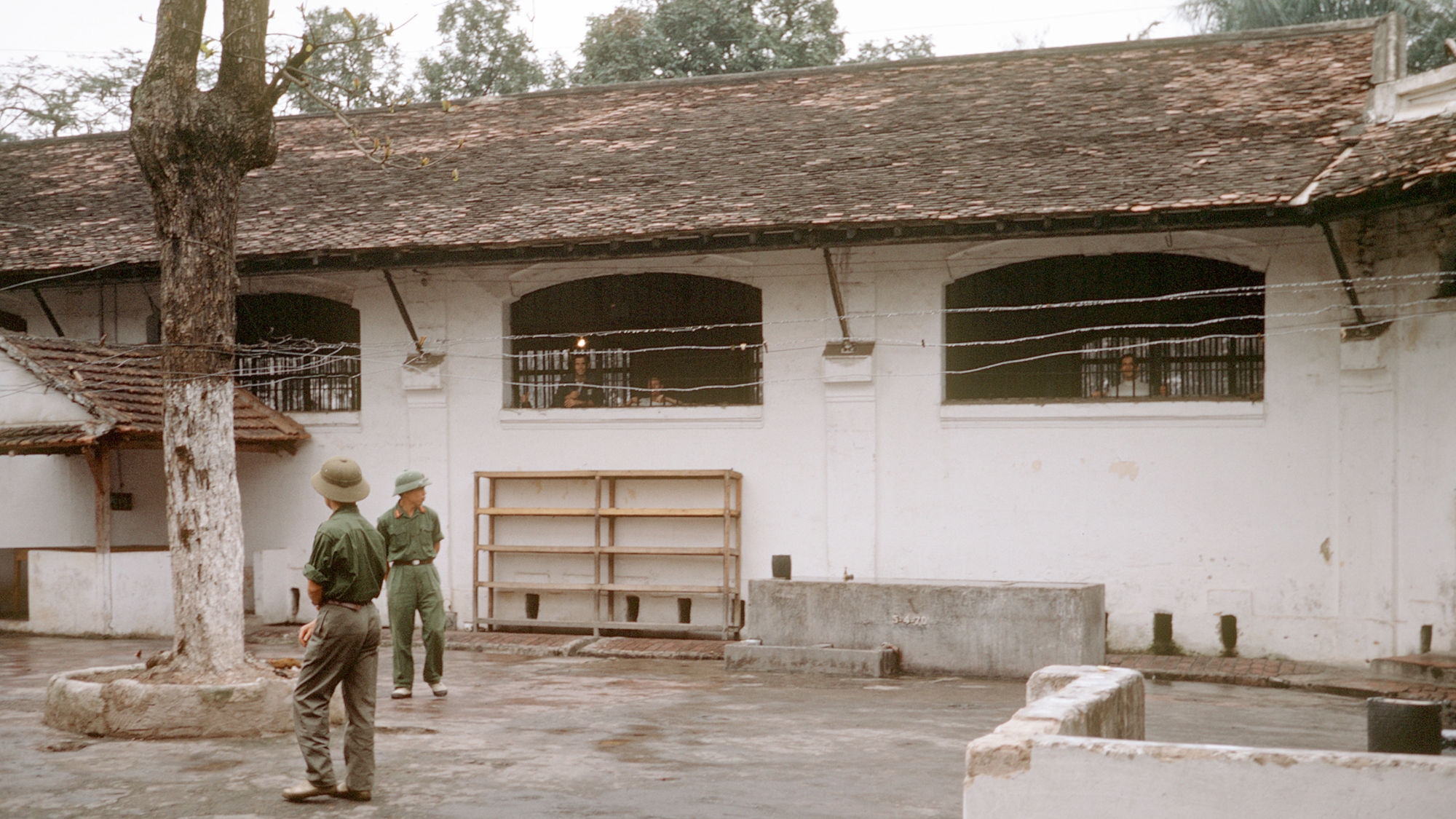
Exterior
Hanoi Hilton
An exterior shot of the Hanoi Hilton, taken In January 1973 prior to the prisoners' return.
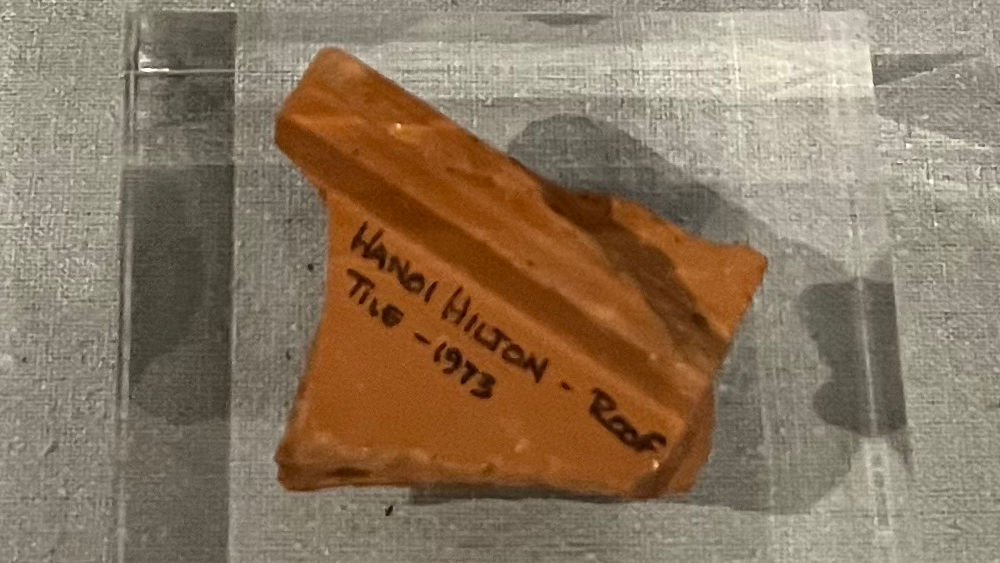
Roof Tile
Hanoi Hilton
Hoa Lo, or the Hanoi Hilton as it came to be known by POWs, was a French colonial-era prison built outside of Hanoi, Vietnam. Among the more well-known veterans held in captivity at the Hanoi Hilton were John McCain, James Stockdale, and Everett Alvarez. They, along with other POWs, were routinely interrogated and tortured by North Vietnamese prison guards, and were subjected to years of mental and physical abuse.
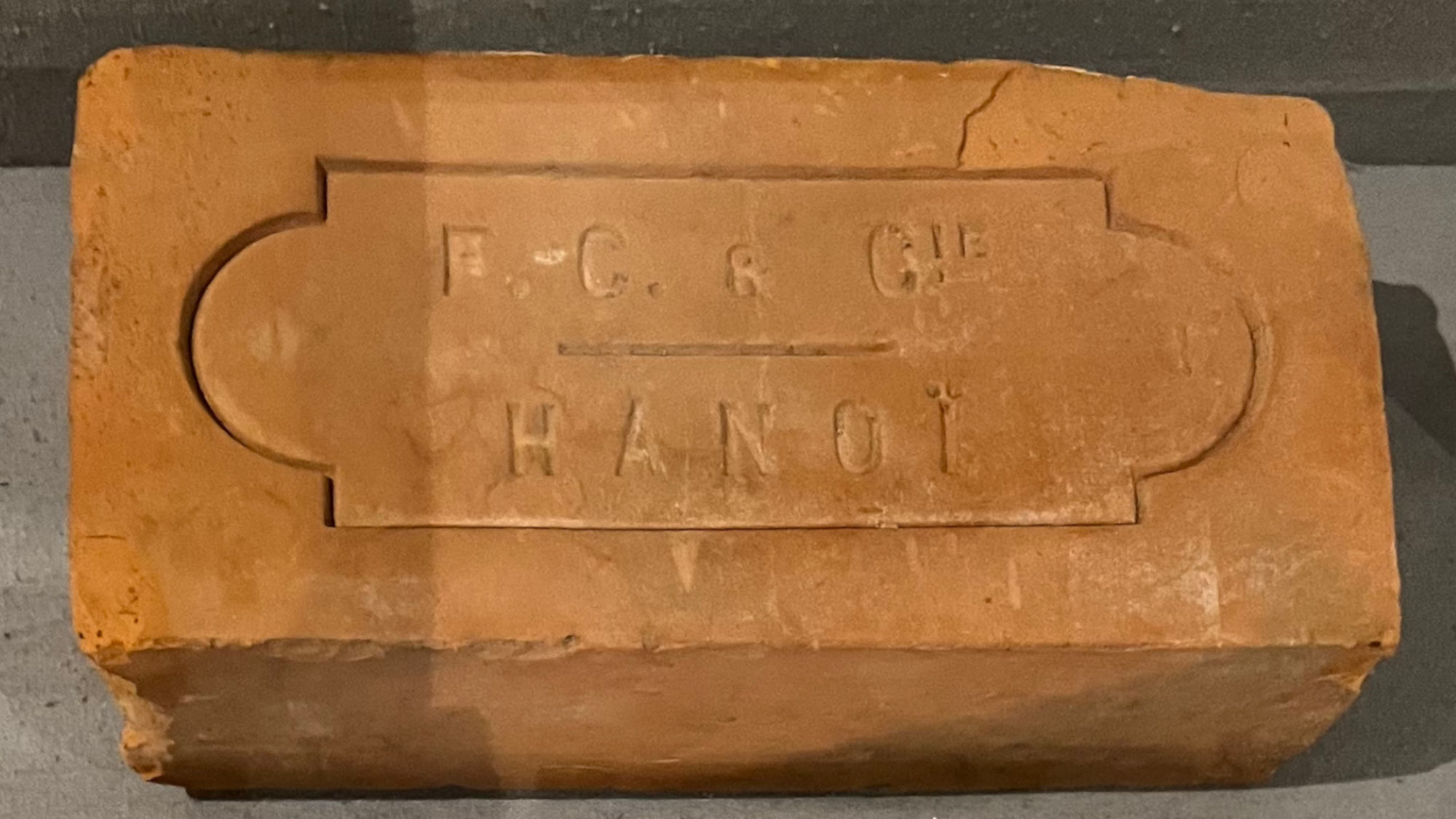
Brick
Hanoi Hilton
This brick was manufactured by the French silversmith company Foret Collin and Company for construction at the Maison Centrale. Built in phases between 1886 and 1901, the Maison Centrale originally housed political prisoners during French colonial occupation in Indochina. The prison was known to locals as Hoa Lo, which translates to "Hell's Hole," in reference to the wood and coal-fire shops in the area.
A significant portion of the prison was demolished to make way for new high-rise buildings. A Vietnam veteran who lived nearby collected several of these bricks, after being told by the construction crew that the rubble would be sent to the dump. These bricks were later given to Commander Everett Alvarez, Senator John McCain, and more than 100 other POWs.
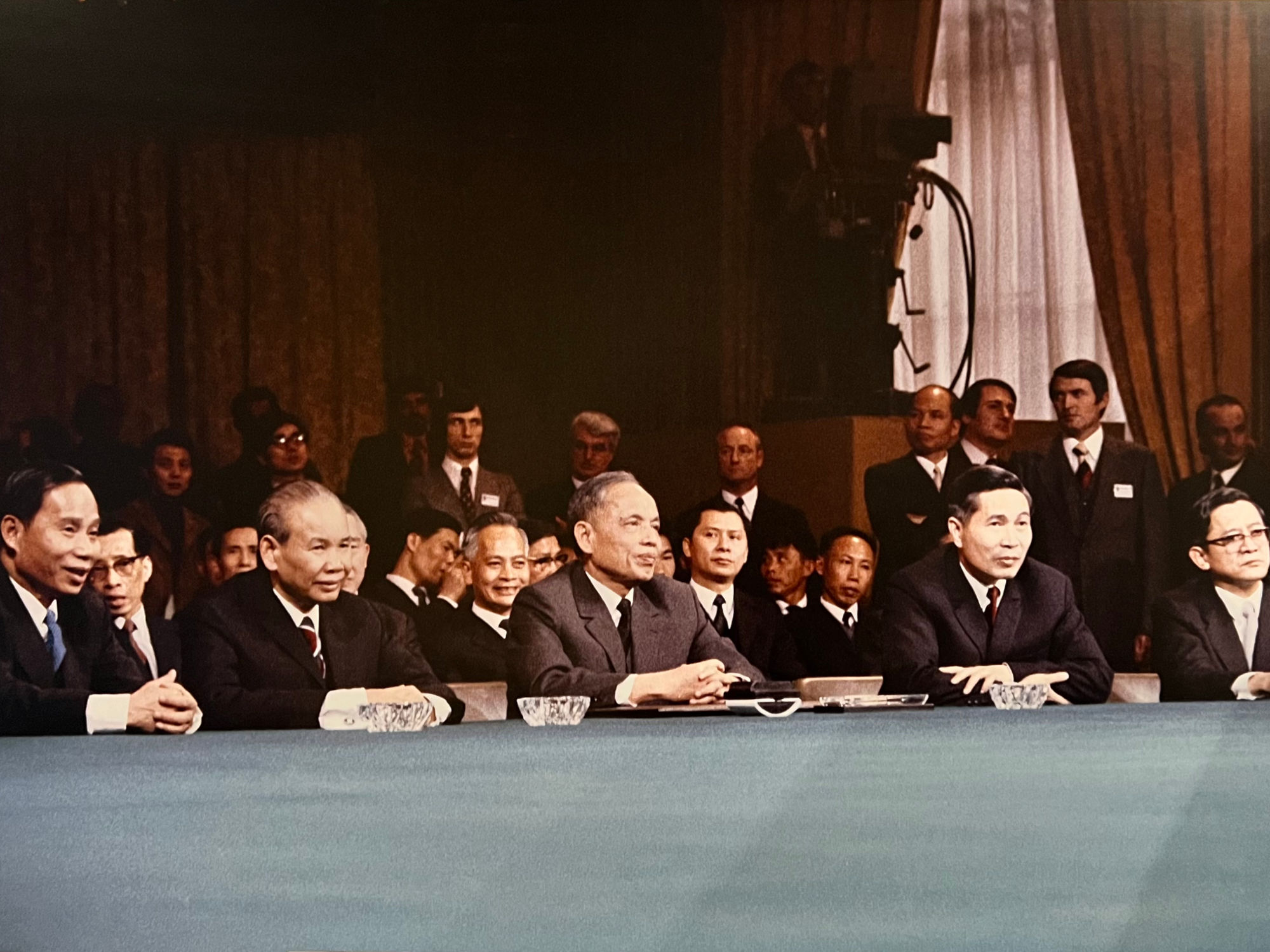
Ceasefire Agreement
Paris Accords
North Vietnamese negotiators during the morning session of the Vietnam Peace Agreements in Paris, France. Nguyen Duy Trinh (Foreign Minister of North Vietnam) (seated center) signs the ceasefire agreement this day. January 27 1973.
| PRE-VIETNAM WAR: | |
|---|---|
| PAGE 1 | |
| What is a POW? | |
| 1775 | American Revolution POWs |
| 1812 | War of 1812 POWs |
| 1865 | Civil War POWs |
| 1917 | World War I POWs |
| 1920 | Ho Chi Minh |
| 1941 | World War Ii POWs |
| 1942 | World War II Japanese Internment |
| 1945 | Brief History of Vietnam |
| 1947 | Truman Doctrine |
| 1949 | Geneva Conventions |
| 1950 | Korean War POWs |
| 1954 | Indochina Communist Expansion |
| 1954 | 17th Parallel |
| 1955 | POW Code of Conduct |
| 1963 | Tiger Cages |
| THE NIXON YEARS: | |
|---|---|
| THIS PAGE | |
| 1968 | 1968 Campaign |
| Requirements For Peace | |
| 1969 | Alive or Dead? |
| Ross Perot's Christmas Delivery | |
| 1970 | Missing in Action |
| The Camps | |
| POW / MIA Bracelets | |
| 1971 | Write Hanoi |
| Live From Space | |
| 1972 | Air War in Vietnam |
| Operation Linebacker II | |
